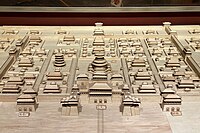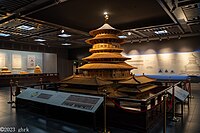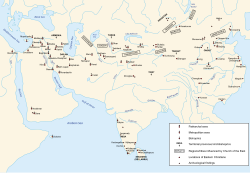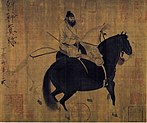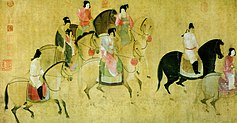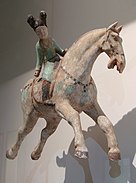Tang dynasty
Tang 唐 | |||||||||||||||||||||||||
|---|---|---|---|---|---|---|---|---|---|---|---|---|---|---|---|---|---|---|---|---|---|---|---|---|---|
| |||||||||||||||||||||||||
 | |||||||||||||||||||||||||
| Capital | |||||||||||||||||||||||||
| Common languages | Middle Chinese | ||||||||||||||||||||||||
| Religion | |||||||||||||||||||||||||
| Government | Absolute monarchy | ||||||||||||||||||||||||
| Emperor | |||||||||||||||||||||||||
• 618–626 (first) | Emperor Gaozu | ||||||||||||||||||||||||
• 626–649 | Emperor Taizong | ||||||||||||||||||||||||
• 712–756 | Emperor Xuanzong | ||||||||||||||||||||||||
• 904–907 (last) | Emperor Ai | ||||||||||||||||||||||||
| Historical era | Medieval East Asia | ||||||||||||||||||||||||
| June 18, 618 | |||||||||||||||||||||||||
• Wu Zhou interregnum | 690–705 | ||||||||||||||||||||||||
| 755–763 | |||||||||||||||||||||||||
• Abdication in favor of Later Liang | June 1, 907 | ||||||||||||||||||||||||
| Area | |||||||||||||||||||||||||
| 715[4][5] | 5,400,000 km2 (2,100,000 sq mi) | ||||||||||||||||||||||||
| Population | |||||||||||||||||||||||||
• 7th century | 50 million | ||||||||||||||||||||||||
• 9th century | 80 million | ||||||||||||||||||||||||
| Currency | Cash coins | ||||||||||||||||||||||||
| |||||||||||||||||||||||||
| Tang dynasty | |||
|---|---|---|---|
 "Tang dynasty" in Han characters | |||
| Chinese | 唐朝 | ||
| Hanyu Pinyin | Tángcháo | ||
| |||
| Part of a series on the |
| History of China |
|---|
The Tang dynasty (/tɑːŋ/,[6] [tʰǎŋ]; Chinese: 唐朝[a]), or the Tang Empire, was an imperial dynasty of China that ruled from 618 to 907, with an interregnum between 690 and 705. It was preceded by the Sui dynasty and followed by the Five Dynasties and Ten Kingdoms period. Historians generally regard the Tang as a high point in Chinese civilization, and a golden age of cosmopolitan culture.[8] Tang territory, acquired through the military campaigns of its early rulers, rivaled that of the Han dynasty.
The Li family founded the dynasty after taking advantage of a period of Sui decline and precipitating their final collapse, in turn inaugurating a period of progress and stability in the first half of the dynasty's rule. The dynasty was formally interrupted during 690–705 when Empress Wu Zetian seized the throne, proclaiming the Wu Zhou dynasty and becoming the only legitimate Chinese empress regnant. The devastating An Lushan Rebellion (755–763) led to the decline of central authority in the dynasty's latter half. Like the previous Sui dynasty, the Tang maintained a civil-service system by recruiting scholar-officials through standardized examinations and recommendations to office. The rise of regional military governors known as jiedushi during the 9th century undermined this civil order. The dynasty and central government went into decline by the latter half of the 9th century; agrarian rebellions resulted in mass population loss and displacement, widespread poverty, and further government dysfunction that ultimately ended the dynasty in 907.
The Tang capital at Chang'an (present-day Xi'an) was the world's most populous city for much of the dynasty's existence. Two censuses of the 7th and 8th centuries estimated the empire's population at about 50 million people,[9][10] which grew to an estimated 80 million by the dynasty's end.[11][12][b] From its numerous subjects, the dynasty raised professional and conscripted armies of hundreds of thousands of troops to contend with nomadic powers for control of Inner Asia and the lucrative trade-routes along the Silk Road. Far-flung kingdoms and states paid tribute to the Tang court, while the Tang also indirectly controlled several regions through a protectorate system. In addition to its political hegemony, the Tang exerted a powerful cultural influence over neighboring East Asian nations such as Japan and Korea.
Chinese culture flourished and further matured during the Tang era. It is traditionally considered the greatest age for Chinese poetry.[13] Two of China's most famous poets, Li Bai and Du Fu, belonged to this age, contributing with poets such as Wang Wei to the monumental Three Hundred Tang Poems. Many famous painters such as Han Gan, Zhang Xuan, and Zhou Fang were active, while Chinese court music flourished with instruments such as the popular pipa. Tang scholars compiled a rich variety of historical literature, as well as encyclopedias and geographical works. Notable innovations included the development of woodblock printing. Buddhism became a major influence in Chinese culture, with native Chinese sects gaining prominence. However, in the 840s, Emperor Wuzong enacted policies to suppress Buddhism, which subsequently declined in influence.
History
Establishment
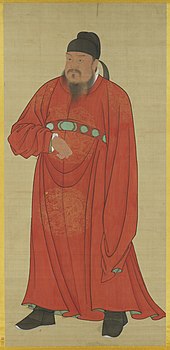
The Li family had ethnic Han origins, and it belonged to the northwest military aristocracy prevalent during the Sui dynasty.[14][15] According to official Tang records, they were paternally descended from Laozi, the traditional founder of Taoism (whose personal name was Li Dan or Li Er), the Han dynasty general Li Guang, and Li Gao, the founder of the Han-ruled Western Liang kingdom.[16][17][18] This family was known as the Longxi Li lineage, and it included the prominent Tang poet Li Bai. Aside from traditional historiography, some modern historians have suggested that the Tang imperial family might have modified its genealogy to conceal Xianbei heritage.[19][20] The Tang emperors had part-Xianbei maternal ancestry, from Emperor Gaozu of Tang's part-Xianbei mother, Duchess Dugu.[21][22]

Li Yuan, the founder of the Tang dynasty, was Duke of Tang and governor of Taiyuan, the capital of modern Shanxi, during the collapse of the Sui dynasty.[14][24] He had prestige and military experience, and was a first cousin of Emperor Yang of Sui (their mothers were both one of the Dugu sisters).[9] Li Yuan rose in rebellion in 617, along with his son and his equally militant daughter Princess Pingyang (d. 623), who raised and commanded her own troops. In winter 617, Li Yuan occupied Chang'an, relegated Emperor Yang to the position of Taishang Huang or retired emperor, and acted as regent to the puppet child-emperor, Yang You.[25] On the news of Emperor Yang's murder by General Yuwen Huaji on June 18, 618, Li Yuan declared himself the emperor of a new dynasty, the Tang.[25][26]
Li Yuan, known as Emperor Gaozu of Tang, ruled until 626, when he was forcefully deposed by his son Li Shimin, the Prince of Qin. Li Shimin had commanded troops since the age of 18 years old, had prowess with bow and arrow, sword and lance and was known for his effective cavalry charges.[9][27] Fighting a numerically superior army, he defeated Dou Jiande (573–621) at Luoyang in the Battle of Hulao on May 28, 621.[28][29] Due to fear of assassination, Li Shimin ambushed and killed two of his brothers, Li Yuanji (b. 603) and crown prince Li Jiancheng (b. 589), in the Xuanwu Gate Incident on July 2, 626.[30] Shortly thereafter, his father abdicated in his favor and Li Shimin ascended the throne. He is conventionally known by his temple name Taizong.[9]
Although killing two brothers and deposing his father contradicted the Confucian value of filial piety,[30] Taizong showed himself to be a capable leader who listened to the advice of the wisest members of his council.[9] In 628, Emperor Taizong held a Buddhist memorial service for the casualties of war, and in 629 he had Buddhist monasteries erected at the sites of major battles so that monks could pray for the fallen on both sides of the fight.[31]
During the Tang campaign against the Eastern Turks, the Eastern Turkic Khaganate was destroyed after the capture of its ruler, Illig Qaghan by the famed Tang military officer Li Jing (571–649), who later became a Chancellor of the Tang dynasty. With this victory, the Turks accepted Taizong as their khagan, a title rendered as Tian Kehan in addition to his rule as emperor of China under the traditional title "Son of Heaven".[32][33] Taizong was succeeded by his son Li Zhi (as Emperor Gaozong) in 649 CE.
The Tang dynasty further led the Tang campaigns against the Western Turks. Early military conflicts were a result of the Tang interventions in the rivalry between the Western and Eastern Turks in order to weaken both. Under Emperor Taizong, campaigns were dispatched in the Western Regions against Gaochang in 640, Karasahr in 644 and 648, and Kucha in 648. The wars against the Western Turks continued under Emperor Gaozong, and the Western Turkic Khaganate was finally annexed after General Su Dingfang's defeat of Qaghan Ashina Helu in 657 CE.
Around that time, the Tang court enjoyed the visit of numerous dignitaries from foreign lands. These were portraited in The Gathering of Kings (王會圖; Wánghuìtú), probably painted by Yan Liben (601–673 CE).[34] From right to left are representatives hailing from Lu (魯國)—a reference to the Eastern Wei—Rouran (芮芮國), Persia (波斯國), Baekje (百濟國), Kumedh (胡密丹), Baiti (白題國), Mohe people (靺國), Central India (中天竺), Sri Lanka (獅子國), Northern India (北天竺), Tashkurgan (謁盤陀), Wuxing of the Chouchi ((武興國), Kucha ((龜茲國), Japan (倭國), Goguryeo (高麗國), Khotan (于闐國), Silla (新羅國), Dangchang (宕昌國), Langkasuka (狼牙修), Dengzhi (鄧至國), Yarkand (周古柯), Kabadiyan (阿跋檀), the "Barbarians of Jianping" (建平蠻), and Nudan (女蜑國).
Wu Zetian's usurpation
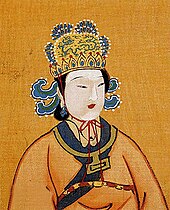
Although she entered Emperor Gaozong's court as the lowly consort, Wu Zetian rose to the highest seat of power in 690, establishing the short-lived Wu Zhou. Empress Wu's rise to power was achieved through cruel and calculating tactics: a popular conspiracy theory stated that she killed her own baby girl and blamed it on Gaozong's empress so that the empress would be demoted.[35] Emperor Gaozong suffered a stroke in 655, and Wu began to make many of his court decisions for him, discussing affairs of state with his councilors, who took orders from her while she sat behind a screen.[36] When Empress Wu's eldest son, the crown prince, began to assert his authority and advocate policies opposed by Empress Wu, he suddenly died in 675. Many suspected he was poisoned by Empress Wu. Although the next heir apparent kept a lower profile, in 680 he was accused by Wu of plotting a rebellion, banished, and later obliged to commit suicide.[37]
In 683, Emperor Gaozong died. He was succeeded by Emperor Zhongzong, his eldest surviving son by Wu. Zhongzong tried to appoint his wife's father as chancellor: after only six weeks on the throne, he was deposed by Empress Wu in favor of his younger brother, Emperor Ruizong.[37] This provoked a group of Tang princes to rebel in 684. Wu's armies suppressed them within two months.[37] She proclaimed the Tianshou era of Wu Zhou on October 16, 690,[38] and three days later demoted Emperor Ruizong to crown prince.[39] He was also forced to give up his father's surname Li in favor of the Empress Wu.[39] She then ruled as China's only empress regnant.
A palace coup on February 20, 705, forced Empress Wu to yield her position on February 22. The next day, her son Zhongzong was restored to power; the Tang was formally restored on March 3. She died soon after.[41] To legitimize her rule, she circulated a document known as the Great Cloud Sutra, which predicted that a reincarnation of the Maitreya Buddha would be a female monarch who would dispel illness, worry, and disaster from the world.[42][43] She even introduced numerous revised written characters to the language, though they reverted to the original forms after her death.[44] Arguably the most important part of her legacy was diminishing the hegemony of the Northwestern aristocracy, allowing people from other clans and regions of China to become more represented in Chinese politics and government.[45][46]
Emperor Xuanzong's reign
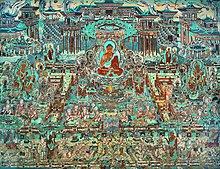
There were many prominent women at court during and after Wu's reign, including Shangguan Wan'er (664–710), a poet, writer, and trusted official in charge of Wu's private office.[48] In 706 the wife of Emperor Zhongzong of Tang, Empress Wei (d. 710), persuaded her husband to staff government offices with his sister and her daughters, and in 709 requested that he grant women the right to bequeath hereditary privileges to their sons (which before was a male right only).[49] Empress Wei eventually poisoned Zhongzong, whereupon she placed his fifteen-year-old son upon the throne in 710. Two weeks later, Li Longji (the later Emperor Xuanzong) entered the palace with a few followers and slew Empress Wei and her faction. He then installed his father Emperor Ruizong (r. 710–712) on the throne.[50] Just as Emperor Zhongzong was dominated by Empress Wei, so too was Ruizong dominated by Princess Taiping.[51] This was finally ended when Princess Taiping's coup failed in 712 (she later hanged herself in 713) and Emperor Ruizong abdicated to Emperor Xuanzong.[50][49]
During the 44-year reign of Emperor Xuanzong, the Tang dynasty reached its height, a golden age with low economic inflation and a toned down lifestyle for the imperial court.[52][46] Seen as a progressive and benevolent ruler, Xuanzong abolished the death penalty in the year 747; all executions had to be approved beforehand by the emperor himself (there were only 24 executions in the year 730).[53] Xuanzong bowed to the consensus of his ministers on policy decisions and made efforts to staff government ministries fairly with different political factions.[51] His staunch Confucian chancellor Zhang Jiuling (673–740) worked to reduce deflation and increase the money supply by upholding the use of private coinage, while his aristocratic and technocratic successor Li Linfu (d. 753) favored government monopoly over the issuance of coinage.[54] After 737, most of Xuanzong's confidence rested in his long-standing chancellor Li Linfu, who championed a more aggressive foreign policy employing non-Chinese generals. This policy ultimately created the conditions for a massive rebellion against Xuanzong.[55]
An Lushan Rebellion and catastrophe
The Tang Empire was at its height of power up until the middle of the 8th century, when the An Lushan Rebellion (December 16, 755 – February 17, 763) destroyed the prosperity of the empire. An Lushan was a half-Sogdian, half-Turk Tang commander since 744, who had experience fighting the Khitans of Manchuria with a victory in 744,[56][57] yet most of his campaigns against the Khitans were unsuccessful.[58] He was given great responsibility in Hebei, which allowed him to rebel with an army of more than 100,000 troops.[56] After capturing Luoyang, he named himself emperor of a new, but short-lived, Yan state.[57] Despite early victories scored by Tang General Guo Ziyi (697–781), the newly recruited troops of the army at the capital were no match for An Lushan's frontier veterans, so the court fled Chang'an.[56] While the heir apparent raised troops in Shanxi and Xuanzong fled to Sichuan province, they called upon the help of the Uyghur Khaganate in 756.[59] The Uyghur khan Moyanchur was greatly excited at this prospect, and married his own daughter to the Chinese diplomatic envoy once he arrived, receiving in turn a Chinese princess as his bride.[59] The Uyghurs helped recapture the Tang capital from the rebels, but they refused to leave until the Tang paid them an enormous sum of tribute in silk.[56][59] Even Abbasid Arabs assisted the Tang in putting down An Lushan's rebellion.[59][60] A massacre of foreign Arab and Persian Muslim merchants by Tian Shengong happened during the An Lushan rebellion in the Yangzhou massacre (760).[61][62] The Tibetans took hold of the opportunity and raided many areas under Chinese control, and even after the Tibetan Empire had fallen apart in 842 (and the Uyghurs soon after) the Tang were in no position to reconquer Central Asia after 763.[56][63] So significant was this loss that half a century later jinshi examination candidates were required to write an essay on the causes of the Tang's decline.[64] Although An Lushan was killed by one of his eunuchs in 757,[59] this time of troubles and widespread insurrection continued until rebel Shi Siming was killed by his own son in 763.[59]
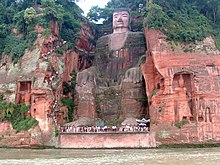

One of the legacies that the Tang government left since 710 was the gradual rise of regional military governors, the jiedushi, who slowly came to challenge the power of the central government.[65] After the An Lushan Rebellion, the autonomous power and authority accumulated by the jiedushi in Hebei went beyond the central government's control. After a series of rebellions between 781 and 784 in today's Hebei, Shandong, Hubei and Henan provinces, the government had to officially acknowledge the jiedushi's hereditary rule without accreditation. The Tang government relied on these governors and their armies for protection and to suppress local revolts. In return, the central government would acknowledge the rights of these governors to maintain their army, collect taxes and even to pass on their title to heirs.[56][66] As time passed, these military governors slowly phased out the prominence of civil officials drafted by exams, and became more autonomous from central authority.[56] The rule of these powerful military governors lasted until 960, when a new civil order under the Song dynasty was established. Also, the abandonment of the equal-field system meant that people could buy and sell land freely. Many poor fell into debt because of this, forced to sell their land to the wealthy, which led to the exponential growth of large estates.[56] With the breakdown of the land allocation system after 755, the central Chinese state barely interfered in agricultural management and acted merely as tax collector for roughly a millennium, save a few instances such as the Song's failed land nationalization during the 13th-century war with the Mongols.[67]
With the central government collapsing in authority over the various regions of the empire, it was recorded in 845 that bandits and river pirates in parties of 100 or more began plundering settlements along the Yangtze River with little resistance.[68] In 858, massive floods along the Grand Canal inundated vast tracts of land and terrain of the North China Plain, which drowned tens of thousands of people in the process.[68] The Chinese belief in the Mandate of Heaven granted to the ailing Tang was also challenged when natural disasters led many to believe that the Tang had lost their right to rule. Furthermore, in 873 a disastrous harvest shook the foundations of the empire; in some areas only half of all agricultural produce was gathered, and tens of thousands faced famine and starvation.[68] In the earlier period of the Tang, the central government was able to meet crises in the harvest, as it was recorded from 714 to 719 that the Tang government responded effectively to natural disasters by extending the price-regulation granary system throughout the country.[68] The central government was able then to build a large surplus stock of foods to ward off the rising danger of famine and increased agricultural productivity through land reclamation.[52][68]
Rebuilding and recovery
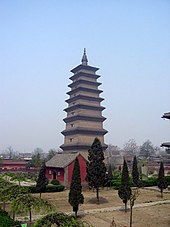
Although these natural calamities and rebellions stained the reputation and hampered the effectiveness of the central government, the early 9th century is nonetheless viewed as a period of recovery for the Tang dynasty.[69] The government's withdrawal from its role in managing the economy had the unintended effect of stimulating trade, as more markets with fewer bureaucratic restrictions were opened up.[70][71] By 780, the old grain tax and labor service of the 7th century was replaced by a semiannual tax paid in cash, signifying the shift to a money economy boosted by the merchant class.[60] Cities in the Jiangnan region to the south, such as Yangzhou, Suzhou, and Hangzhou prospered the most economically during the late Tang period.[70] The government monopoly on salt production, weakened after the An Lushan Rebellion, was placed under the Salt Commission, which became one of the most powerful state agencies, run by capable ministers chosen as specialists. The commission began the practice of selling merchants the rights to buy monopoly salt, which they transported and sold in local markets. In 799 salt accounted for over half of the government's revenues.[56] S.A.M. Adshead writes that this salt tax represents "the first time that an indirect tax, rather than tribute, levies on land or people, or profit from state enterprises such as mines, had been the primary resource of a major state."[72] Even after the power of the central government was in decline after the mid 8th century, it was still able to function and give out imperial orders on a massive scale. The Old Book of Tang, compiled in 945, recorded a government decree issued in 828 that standardized irrigational square-pallet chain pumps throughout the country.
In the second year of the Taihe reign period [828], in the second month ... a standard model of the chain pump was issued from the palace, and the people of Jingzhao Fu (d footnote: the capital) were ordered by the emperor to make a considerable number of machines, for distribution to the people along the Zheng Bai Canal, for irrigation purposes.|[73]
The last great ambitious ruler of the Tang dynasty was Emperor Xianzong (r. 805–820), whose reign was aided by the fiscal reforms of the 780s, including a government monopoly on the salt industry.[74] He also had an effective and well-trained imperial army stationed at the capital led by his court eunuchs; this was the Army of Divine Strategy, numbering 240,000 in strength as recorded in 798.[75] Between the years 806 and 819, Emperor Xianzong conducted seven major military campaigns to quell the rebellious provinces that had claimed autonomy from central authority, managing to subdue all but two of them.[76][77] Under his reign there was a brief end to the hereditary jiedushi, as Xianzong appointed his own military officers and staffed the regional bureaucracies once again with civil officials.[76][77] However, Xianzong's successors proved less capable and more interested in the leisure of hunting, feasting, and playing outdoor sports, allowing eunuchs to amass more power as drafted scholar-officials caused strife in the bureaucracy with factional parties.[77] The eunuchs' power became unchallenged after Emperor Wenzong's (r. 826–840) failed plot to have them overthrown; instead the allies of Emperor Wenzong were publicly executed in the West Market of Chang'an, by the eunuchs' command.[70]

However, the Tang did manage to restore at least indirect control over former Tang territories as far west as the Hexi Corridor and Dunhuang in Gansu. In 848 the ethnic Han Chinese general Zhang Yichao (799–872) managed to wrestle control of the region from the Tibetan Empire during its civil war.[78] Shortly afterwards Emperor Xuānzong of Tang (r. 846–859) acknowledged Zhang as the protector (防禦使; fángyùshǐ) of Sha Prefecture, and military governor of the new Guiyi Circuit.[79]
The Tang dynasty recovered its power decades after the An Lushan rebellion and was still able to launch offensive conquests and campaigns like its destruction of the Uyghur Khaganate in Mongolia in 840–847.[80]
End of the dynasty
In addition to natural calamities and jiedushi amassing autonomous control, the Huang Chao Rebellion (874–884) resulted in the sacking of both Chang'an and Luoyang, and took an entire decade to suppress.[81] It was the Huang Chao rebellion by the native Han rebel Huang Chao that permanently destroyed the power of the Tang dynasty since Huang Chao not only devastated the north but marched into southern China (which An Lushan failed to do due to the Battle of Suiyang). Huang Chao's army in southern China committed the Guangzhou massacre against foreign Arab and Persian Muslim, Zoroastrian, Jewish and Christian merchants in 878–879 at the seaport and trading port of Guangzhou,[82] and captured both Tang dynasty capitals, Luoyang and Chang'an. A medieval Chinese source claimed that Huang Chao killed 8 million people.[83] The Tang never recovered from this rebellion, weakening it for future military powers to replace it. Large groups of bandits in the size of small armies ravaged the countryside in the last years of the Tang. They smuggled illicit salt, ambushed merchants and convoys, and even besieged several walled cities.[84] Amid the sacking of cities and murderous factional strife among eunuchs and officials, the top tier of aristocratic families, which had amassed a large fraction of the landed wealth and official positions, was largely destroyed or marginalized.[85][86]
During the last two decades of the Tang dynasty, the gradual collapse of central authority led to the rise of two prominent rival military figures over northern China: Li Keyong and Zhu Wen.[87] Tang forces had defeated Huang Chao's rebellion with the crucial aid of allied Shatuo, a Turkic people of what is now Shanxi, led by Li Keyong. He was made a jiedushi, and later Prince of Jin, bestowed with the imperial surname Li by the Tang court.[88] Zhu Wen, originally a salt smuggler who served as a lieutenant under the rebel Huang Chao, surrendered to Tang forces. By helping to defeat Huang, he was renamed Zhu Quanzhong ("Zhu of Perfect Loyalty") and granted a series of rapid military promotions to military governor of Xuanwu Circuit.[89][90]
In 901, from his power base of Kaifeng, Zhu Wen seized control of the Tang capital Chang'an and with it the imperial family.[91] By 903 he forced Emperor Zhaozong of Tang to move the capital to Luoyang, preparing to take the throne for himself. In 904 Zhu assassinated Emperor Zhaozong to replace him with the emperor's young son Emperor Ai of Tang. In 905 Zhu executed the brothers of Emperor Ai as well as many officials and Empress Dowager He. In 907 the Tang dynasty was ended when Zhu deposed Ai and took the throne for himself (known posthumously as Emperor Taizu of Later Liang). He established the Later Liang, which inaugurated the Five Dynasties and Ten Kingdoms period. A year later Zhu had the deposed Emperor Ai poisoned to death.[89]
Zhu Wen's hated nemesis Li Keyong died in 908 but, out of loyalty to Tang, Li never claimed the title of emperor. His son Li Cunxu (Emperor Zhuangzong) inherited his title Prince of Jin along with his father's rivalry against Zhu. In 923 Li Cunxu declared a "restored" Tang dynasty, the Later Tang, before toppling the Later Liang dynasty the same year.[92] However, southern China remained splintered into various small kingdoms until most of China was reunified under the Song dynasty (960–1279).[93] Control over parts of northeast China and Manchuria by the Liao dynasty of the Khitan people also stemmed from this period. In 905 their leader Abaoji formed a military alliance with Li Keyong against Zhu Wen but the Khitans eventually turned against the Later Tang, helping another Shatuo leader Shi Jingtang of Later Jin to overthrow Later Tang in 936.[94]
Administration and politics
Initial reforms
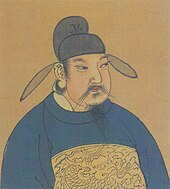
Taizong set out to solve internal problems within the government which had constantly plagued past dynasties. Building upon the Sui legal code, he issued a new legal code that subsequent Chinese dynasties would model theirs upon, as well as neighboring polities in Vietnam, Korea, and Japan.[9] The earliest law code to survive was established in the year 653; it was divided into 500 articles specifying different crimes and penalties ranging from ten blows with a light stick, one hundred blows with a heavy rod, exile, penal servitude, or execution.[95]
The legal code distinguished different levels of severity in meted punishments when different members of the social and political hierarchy committed the same crime.[96] For example, the severity of punishment was different when a servant or nephew killed a master or an uncle than when a master or uncle killed a servant or nephew.[96]

The Tang Code was largely retained by later codes such as the early Ming dynasty (1368–1644) code of 1397,[97] yet there were several revisions in later times, such as improved property rights for women during the Song dynasty (960–1279).[98][99]
The Tang had three departments (Chinese: 省; pinyin: shěng), which were obliged to draft, review, and implement policies respectively. There were also six ministries (Chinese: 部; pinyin: bù) under the administrations that implemented policy, each of which was assigned different tasks. These Three Departments and Six Ministries included the personnel administration, finance, rites, military, justice, and public works—an administrative model which lasted until the fall of the Qing dynasty (1644–1912).[100]
Although the founders of the Tang related to the glory of the earlier Han dynasty (3rd century BC–3rd century AD), the basis for much of their administrative organization was very similar to the previous Northern and Southern dynasties.[9] The Northern Zhou (6th century) fubing system of divisional militia was continued by the Tang, along with farmer-soldiers serving in rotation from the capital or frontier in order to receive appropriated farmland. The equal-field system of the Northern Wei (4th–6th centuries) was also kept, although there were a few modifications.[9]
Although the central and local governments kept an enormous number of records about land property in order to assess taxes, it became common practice in the Tang for literate and affluent people to create their own private documents and signed contracts. These had their own signature and that of a witness and scribe in order to prove in court (if necessary) that their claim to property was legitimate. The prototype of this actually existed since the ancient Han dynasty, while contractual language became even more common and embedded into Chinese literary culture in later dynasties.[101]
The center of the political power of the Tang was the capital city of Chang'an (modern Xi'an), where the emperor maintained his large palace quarters and entertained political emissaries with music, sports, acrobatic stunts, poetry, paintings, and dramatic theater performances. The capital was also filled with incredible amounts of riches and resources to spare. When the Chinese prefectural government officials traveled to the capital in the year 643 to give the annual report of the affairs in their districts, Emperor Taizong discovered that many had no proper quarters to rest in and were renting rooms with merchants. Therefore, Emperor Taizong ordered the government agencies in charge of municipal construction to build every visiting official his own private mansion in the capital.[102]
Imperial examinations
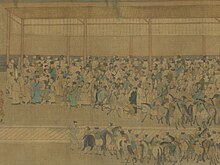
Students of Confucian studies were candidates for the imperial examinations, which qualified their graduates for appointment to the local, provincial, and central government bureaucracies. Two types of exams were given, mingjing (明經; 'illuminating the classics') and jinshi (進士; 'presented scholar').[103] The mingjing was based upon the Confucian classics and tested the student's knowledge of a broad variety of texts.[103] The jinshi tested a student's literary abilities in writing essays in response to questions on governance and politics, as well as in composing poetry.[104] Candidates were also judged on proper deportment, appearance, speech, and calligraphy, all subjective criteria that favored the wealthy over those of more modest means who were unable to pay tutors of rhetoric and writing.[35] Although a disproportionate number of civil officials came from aristocratic families,[35] wealth and noble status were not prerequisites, and the exams were open to all male subjects whose fathers were not of the artisan or merchant classes.[105][35] To promote widespread Confucian education, the Tang government established state-run schools and issued standard versions of the Five Classics with commentaries.[96]
Open competition was designed to draw the best talent into government. But perhaps an even greater consideration for the Tang rulers was to avoid imperial dependence on powerful aristocratic families and warlords by recruiting a body of career officials having no family or local power base. The Tang law code ensured equal division of inherited property amongst legitimate heirs, encouraging social mobility by preventing powerful families from becoming landed nobility through primogeniture.[106] The competition system proved successful, as scholar-officials acquired status in their local communities while developing an esprit de corps that connected them to the imperial court. From Tang times until the end of the Qing dynasty in 1912, scholar-officials served as intermediaries between the people and the government.
Yet the potential of a widespread examination system was not fully realized until the succeeding Song dynasty, when the merit-driven scholar official largely shed his aristocratic habits and defined his social status through the examination system.[107][108][109]
The examination system, used only on a small scale in Sui and Tang times, played a central role in the fashioning of this new elite. The early Song emperors, concerned above all to avoid domination of the government by military men, greatly expanded the civil service examination system and the government school system.[110]
Religion and politics

From the outset, religion played a role in Tang politics. In his bid for power, Li Yuan had attracted a following by claiming descent from the Taoist sage Laozi (fl. 6th century BC).[111] People bidding for office would request the prayers of Buddhist monks, with successful aspirants making donations in return. Before the persecution of Buddhism in the 9th century, Buddhism and Taoism were both accepted.
Religion was central in the reign of Emperor Xuanzong (r. 712–756). The Emperor invited Taoist and Buddhist monks and clerics to his court, exalted Laozi with grand titles, wrote commentary on Taoist scriptures, and set up a school to prepare candidates for Taoist examinations. In 726 he called upon the Indian monk Vajrabodhi (671–741) to perform tantric rites to avert a drought. In 742 he personally held the incense burner while Amoghavajra (705–774, patriarch of the Shingon school) recited "mystical incantations to secure the victory of Tang forces."[50]
Emperor Xuanzong closely regulated religious finances. Near the beginning of his reign in 713, he liquidated the Inexhaustible Treasury of a prominent Buddhist monastery in Chang'an which had collected vast riches as multitudes of anonymous repentants left money, silk, and treasure at its doors. Although the monastery used its funds generously, the Emperor condemned it for fraudulent banking practices, and distributed its wealth to other Buddhist and Taoist monasteries, and to repair local statues, halls, and bridges.[112] In 714, he forbade Chang'an shops from selling copied Buddhist sutras, giving a monopoly of this trade to the Buddhist clergy.[113]
Taxes and the census
The Tang dynasty government attempted to create an accurate census of the empire's population, mostly for effective taxation and military conscription. The early Tang government established modest grain and cloth taxes on each household, persuading households to register and provide the government with accurate demographic information.[9] In the official census of 609, the population was tallied at 9 million households, about 50 million people,[9] and this number did not increase in the census of 742.[114] Patricia Ebrey writes that nonwithstanding census undercounting, China's population had not grown significantly since the earlier Han dynasty, which recorded 58 million people in the year 2.[9][115] S.A.M. Adshead disagrees, estimating about 75 million people by 750.[116]
In the Tang census of 754, there were 1,859 cities, 321 prefectures, and 1,538 counties throughout the empire.[117] Although there were many large and prominent cities, the rural and agrarian areas comprised some 80 to 90% of the population.[118] There was also a dramatic migration from northern to southern China, as the North held 75% of the overall population at the dynasty's inception, which by its end was reduced to 50%.[119]
The Chinese population would not dramatically increase until the Song dynasty, when it doubled to 100 million because of extensive rice cultivation in central and southern China, coupled with higher yields of grain sold in a growing market.[120]
Military and foreign policy
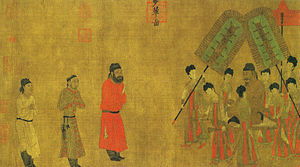
Protectorates and tributaries
The 7th and first half of the 8th century are generally considered to be the era in which the Tang reached the zenith of its power. In this period, Tang control extended further west than any previous dynasty, stretching from north Vietnam in the south, to a point north of Kashmir bordering Persia in the west, to northern Korea in the north-east.[121]
Some of the kingdoms paying tribute to the Tang dynasty included Kashmir, Nepal, Khotan, Kucha, Kashgar, Silla, Champa, and kingdoms located in Amu Darya and Syr Darya valley.[122][123] Turkic nomads addressed the Emperor of Tang China as Tian Kehan.[33] After the widespread Göktürk revolt of Shabolüe Khan (d. 658) was put down at Issyk Kul in 657 by Su Dingfang (591–667), Emperor Gaozong established several protectorates governed by a Protectorate General or Grand Protectorate General, which extended the Chinese sphere of influence as far as Herat in Western Afghanistan.[124] Protectorate Generals were given a great deal of autonomy to handle local crises without waiting for central admission. After Xuanzong's reign, jiedushi were given enormous power, including the ability to maintain their own armies, collect taxes, and pass their titles on hereditarily. This is commonly recognized as the beginning of the fall of Tang's central government.[56][65]
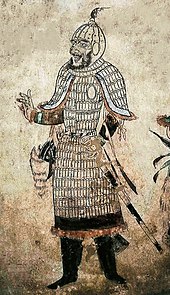
Soldiers and conscription
By the year 737, Emperor Xuanzong discarded the policy of conscripting soldiers that were replaced every three years, replacing them with long-service soldiers who were more battle-hardened and efficient. It was more economically feasible as well, since training new recruits and sending them out to the frontier every three years drained the treasury.[125] By the late 7th century, the fubing troops began abandoning military service and the homes provided to them in the equal-field system. The supposed standard of 100 mu of land allotted to each family was in fact decreasing in size in places where population expanded and the wealthy bought up most of the land.[126] Hard-pressed peasants and vagrants were then induced into military service with benefits of exemption from both taxation and corvée labor service, as well as provisions for farmland and dwellings for dependents who accompanied soldiers on the frontier.[127] By the year 742 the total number of enlisted troops in the Tang armies had risen to about 500,000 men.[125]
Eastern regions
In East Asia, Tang Chinese military campaigns were less successful elsewhere than in previous imperial Chinese dynasties. Like the emperors of the Sui dynasty before him, Taizong established a military campaign in 644 against the Korean kingdom of Goguryeo in the Goguryeo–Tang War; however, this led to its withdrawal in the first campaign because they failed to overcome the successful defense led by General Yeon Gaesomun. Allying with the Korean Silla Kingdom, the Chinese fought against Baekje and their Yamato Japanese allies in the Battle of Baekgang in August 663, a decisive Tang–Silla victory. The Tang dynasty navy had several different ship types at its disposal to engage in naval warfare, these ships described by Li Quan in his Taipai Yinjing (Canon of the White and Gloomy Planet of War) of 759.[128] The Battle of Baekgang was actually a restoration movement by remnant forces of Baekje, since their kingdom was toppled in 660 by a joint Tang–Silla invasion, led by Chinese general Su Dingfang and Korean general Kim Yushin (595–673). In another joint invasion with Silla, the Tang army severely weakened the Goguryeo Kingdom in the north by taking out its outer forts in the year 645. With joint attacks by Silla and Tang armies under commander Li Shiji (594–669), the Kingdom of Goguryeo was destroyed by 668.[129]

Although they were formerly enemies, the Tang accepted officials and generals of Goguryeo into their administration and military, such as the brothers Yeon Namsaeng (634–679) and Yeon Namsan (639–701). From 668 to 676, the Tang Empire controlled northern Korea. However, in 671 Silla broke the alliance and began the Silla–Tang War to expel the Tang forces. At the same time the Tang faced threats on its western border when a large Chinese army was defeated by the Tibetans on the Dafei River in 670.[130] By 676, the Tang army was expelled out of Korea by a unified Silla.[131] Following a revolt of the Eastern Turks in 679, the Tang abandoned its Korean campaigns.[130]
Although the Tang had fought the Japanese, they still held cordial relations with Japan. There were numerous Imperial embassies to China from Japan, diplomatic missions that were not halted until 894 by Emperor Uda (r. 887–897), upon persuasion by Sugawara no Michizane (845–903).[132] The Japanese Emperor Tenmu (r. 672–686) even established his conscripted army on that of the Chinese model, based his state ceremonies on the Chinese model, and constructed his palace at Fujiwara on the Chinese model of architecture.[133]
Many Chinese Buddhist monks came to Japan to help further the spread of Buddhism as well. Two 7th-century monks in particular, Zhi Yu and Zhi You, visited the court of Emperor Tenji (r. 661–672), whereupon they presented a gift of a south-pointing chariot that they had crafted.[134] This 3rd century mechanically driven directional-compass vehicle (employing a differential gear) was again reproduced in several models for Tenji in 666, as recorded in the Nihon Shoki of 720.[134] Japanese monks also visited China; such was the case with Ennin (794–864), who wrote of his travel experiences including travels along China's Grand Canal.[135][136] The Japanese monk Enchin (814–891) stayed in China from 839 to 847 and again from 853 to 858, landing near Fuzhou, Fujian and setting sail for Japan from Taizhou, Zhejiang during his second trip to China.[137][76]
Western and Northern regions
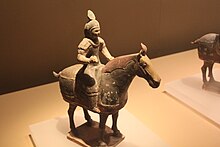
The Sui and Tang carried out successful military campaigns against the steppe nomads. Chinese foreign policy to the north and west now had to deal with Turkic nomads, who were becoming the most dominant ethnic group in Central Asia.[138][139] To handle and avoid any threats posed by the Turks, the Sui government repaired fortifications and received their trade and tribute missions.[104] They sent four royal princesses to form marriage alliances with Turkic clan leaders, in 597, 599, 614, and 617. The Sui stirred trouble and conflict amongst ethnic groups against the Turks.[140][141] As early as the Sui dynasty, the Turks had become a major militarized force employed by the Chinese. When the Khitans began raiding northeast China in 605, a Chinese general led 20,000 Turks against them, distributing Khitan livestock and women to the Turks as a reward.[142] On two occasions between 635 and 636, Tang royal princesses were married to Turk mercenaries or generals in Chinese service.[141] Throughout the Tang dynasty until the end of 755, there were approximately ten Turkic generals serving under the Tang.[143][144] While most of the Tang army was made of fubing Chinese conscripts, the majority of the troops led by Turkic generals were of non-Chinese origin, campaigning largely in the western frontier where the presence of fubing troops was low.[145] Some "Turkic" troops were tribalized Han Chinese, a desinicized people.[146]
Civil war in China was almost totally diminished by 626, along with the defeat in 628 of the Ordos Chinese warlord Liang Shidu; after these internal conflicts, the Tang began an offensive against the Turks.[147] In the year 630, Tang armies captured areas of the Ordos Desert, modern-day Inner Mongolia province, and southern Mongolia from the Turks.[142][148] After this military victory, On June 11, 631, Emperor Taizong also sent envoys to the Xueyantuo bearing gold and silk in order to persuade the release of enslaved Chinese prisoners who were captured during the transition from Sui to Tang from the northern frontier; this embassy succeeded in freeing 80,000 Chinese men and women who were then returned to China.[149][150]
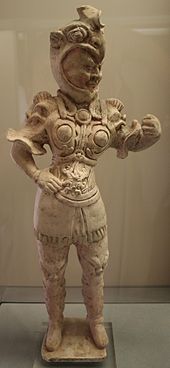
While the Turks were settled in the Ordos region (former territory of the Xiongnu), the Tang government took on the military policy of dominating the central steppe. Like the earlier Han dynasty, the Tang dynasty (along with Turkic allies) conquered and subdued Central Asia during the 640s and 650s.[104] During Emperor Taizong's reign alone, large campaigns were launched against not only the Göktürks, but also separate campaigns against the Tuyuhun, the oasis city-states, and the Xueyantuo. Under Emperor Gaozong, a campaign led by the general Su Dingfang was launched against the Western Turks ruled by Ashina Helu.[151]
The Tang Empire competed with the Tibetan Empire for control of areas in Inner and Central Asia, which was at times settled with marriage alliances such as the marrying of Princess Wencheng (d. 680) to Songtsän Gampo (d. 649).[152][153] A Tibetan tradition mentions that Chinese troops captured Lhasa after Songtsän Gampo's death,[154] but no such invasion is mentioned in either Chinese annals or the Tibetan manuscripts of Dunhuang.[155]
There was a long string of conflicts with Tibet over territories in the Tarim Basin between 670 and 692, and in 763 the Tibetans even captured Chang'an for fifteen days during the An Shi Rebellion.[156][157] In fact, it was during this rebellion that the Tang withdrew its western garrisons stationed in what is now Gansu and Qinghai, which the Tibetans then occupied along with the territory of what is now Xinjiang.[158] Hostilities between the Tang and Tibet continued until they signed a formal peace treaty in 821.[159] The terms of this treaty, including the fixed borders between the two countries, are recorded in a bilingual inscription on a stone pillar outside the Jokhang temple in Lhasa.[160]

During the Islamic conquest of Persia (633–656), the son of the last ruler of the Sassanid Empire, Prince Peroz and his court moved to Tang China.[122][161] According to the Old Book of Tang, Peroz was made the head of a Governorate of Persia in what is now Zaranj, Afghanistan. During this conquest of Persia, the Rashidun Caliph Uthman Ibn Affan (r. 644–656) sent an embassy to the Tang court at Chang'an.[144] Arab sources claim Umayyad commander Qutayba ibn Muslim briefly took Kashgar from China and withdrew after an agreement,[162] but modern historians entirely dismiss this claim.[163][164][165] The Arab Umayyad Caliphate in 715 deposed Ikhshid, the king the Fergana Valley, and installed a new king Alutar on the throne. The deposed king fled to Kucha (seat of Anxi Protectorate), and sought Chinese intervention. The Chinese sent 10,000 troops under Zhang Xiaosong to Ferghana. He defeated Alutar and the Arab occupation force at Namangan and reinstalled Ikhshid on the throne.[166] The Tang dynasty Chinese defeated the Arab Umayyad invaders at the Battle of Aksu (717). The Arab Umayyad commander Al-Yashkuri and his army fled to Tashkent after they were defeated.[167] The Turgesh then crushed the Arab Umayyads and drove them out. By the 740s, the Arabs under the Abbasid Caliphate in Khorasan had reestablished a presence in the Ferghana basin and in Sogdiana. At the Battle of Talas in 751, Karluk mercenaries under the Chinese defected, helping the Arab armies of the Caliphate to defeat the Tang force under commander Gao Xianzhi. Although the battle itself was not of the greatest significance militarily, this was a pivotal moment in history, as it marks the spread of Chinese papermaking[168][169] into regions west of China as captured Chinese soldiers shared the technique of papermaking to the Arabs. These techniques ultimately reached Europe by the 12th century through Arab-controlled Spain.[170] Although they had fought at Talas, on June 11, 758, an Abbasid embassy arrived at Chang'an simultaneously with the Uighur Turks bearing gifts for the Tang Emperor.[171] In 788–789 the Chinese concluded a military alliance with the Uighur Turks who twice defeated the Tibetans, in 789 near the town of Gaochang in Dzungaria, and in 791 near Ningxia on the Yellow River.[172]

Joseph Needham writes that a tributary embassy came to the court of Emperor Taizong in 643 from the Patriarch of Antioch.[173] However, Friedrich Hirth and other sinologists such as S.A.M. Adshead have identified Fu lin (拂菻) in the Old and New Book of Tang as the Byzantine Empire, which those histories directly associated with Daqin (i.e. the Roman Empire).[174][175][176] The embassy sent in 643 by Boduoli (波多力) was identified as Byzantine ruler Constans II Pogonatos (Kōnstantinos Pogonatos, or "Constantine the Bearded") and further embassies were recorded as being sent into the 8th century.[175][176][174] S.A.M. Adshead offers a different transliteration stemming from "patriarch" or "patrician", possibly a reference to one of the acting regents for the young Byzantine monarch.[177] The Old and New Book of Tang also provide a description of the Byzantine capital Constantinople,[178][179] including how it was besieged by the Da shi (大食, i.e. Umayyad Caliphate) forces of Muawiyah I, who forced them to pay tribute to the Arabs.[175][180][c] The 7th-century Byzantine historian Theophylact Simocatta wrote about the reunification of northern and southern China by the Sui dynasty (dating this to the time of Emperor Maurice); the capital city Khubdan (from Old Turkic Khumdan, i.e. Chang'an); the basic geography of China including its previous political division around the Yangtze River; the name of China's ruler Taisson meaning "Son of God", but possibly derived from the name of the contemporaneous ruler Emperor Taizong.[181]
Economy
Through use of the land trade along the Silk Road and maritime trade by sail at sea, the Tang were able to acquire and gain many new technologies, cultural practices, rare luxury, and contemporary items. From Europe, the Middle East, Central and South Asia, the Tang dynasty were able to acquire new ideas in fashion, new types of ceramics, and improved silver-smithing techniques.[183] The Tang Chinese also gradually adopted the foreign concept of stools and chairs as seating, whereas the Chinese beforehand always sat on mats placed on the floor.[184] People of the Middle East coveted and purchased in bulk Chinese goods such as silks, lacquerwares, and porcelain wares.[185] Songs, dances, and musical instruments from foreign regions became popular in China during the Tang dynasty.[186][187] These musical instruments included oboes, flutes, and small lacquered drums from Kucha in the Tarim Basin, and percussion instruments from India such as cymbals.[186] At the court there were nine musical ensembles (expanded from seven in the Sui dynasty) that played ecletic Asian music.[188]

There was great interaction with India, a hub for Buddhist knowledge, with famous travelers such as Xuanzang (d. 664) visiting the South Asian state. After a 17-year-long trip, Xuanzang managed to bring back valuable Sanskrit texts to be translated into Chinese. There was also a Turkic–Chinese dictionary available for serious scholars and students, while Turkic folk songs gave inspiration to some Chinese poetry.[189][190] In the interior of China, trade was facilitated by the Grand Canal and the Tang government's rationalization of the greater canal system that reduced costs of transporting grain and other commodities.[52] The state also managed roughly 32,100 km (19,900 mi) of postal service routes by horse or boat.[191]
Silk Road

Although the Silk Road from China to Europe and the Western World was initially formulated during the reign of Emperor Wu (141–87 BC) during the Han, it was reopened by the Tang in 639 when Hou Junji (d. 643) conquered the West, and remained open for almost four decades. It was closed after the Tibetans captured it in 678, but in 699, during Empress Wu's period, the Silk Road reopened when the Tang reconquered the Four Garrisons of Anxi originally installed in 640,[192] once again connecting China directly to the West for land-based trade.[193]
The Tang captured the vital route through the Gilgit Valley from Tibet in 722, lost it to the Tibetans in 737, and regained it under the command of the Goguryeo-Korean General Gao Xianzhi.[194] When the An Lushan Rebellion ended in 763, the Tang Empire withdrew its troops from its western lands, allowing the Tibetan Empire to largely cut off China's direct access to the Silk Road.[159] An internal rebellion in 848 ousted the Tibetan rulers, and the Tang regained the northwestern prefectures from Tibet in 851. These lands contained crucial grazing areas and pastures for raising horses that the Tang dynasty desperately needed.[159][195]
Despite the many expatriate European travelers coming into China to live and trade, many travelers, mainly religious monks and missionaries, recorded China's stringent immigrant laws. As the monk Xuanzang and many other monk travelers attested to, there were many government checkpoints along the Silk Road that examined travel permits into the Tang Empire. Furthermore, banditry was a problem along the checkpoints and oasis towns, as Xuanzang also recorded that his group of travelers were assaulted by bandits on multiple occasions.[185]
The Silk Road also affected the art from the period. Horses became a significant symbol of prosperity and power as well as an instrument of military and diplomatic policy. Horses were also revered as a relative of the dragon.[196]
Seaports and maritime trade
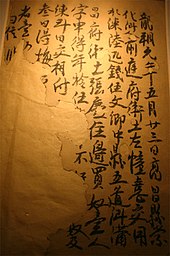
Chinese envoys had been sailing through the Indian Ocean to states of India since perhaps the 2nd century BC,[197][198] yet it was during the Tang dynasty that a strong Chinese maritime presence could be found in the Persian Gulf and Red Sea, into Persia, Mesopotamia (sailing up the Euphrates River in modern-day Iraq), Arabia, Egypt, Aksum (Ethiopia), and Somalia in the Horn of Africa.[199]
During the Tang dynasty, thousands of foreign expatriate merchants came and lived in numerous Chinese cities to do business with China, including Persians, Arabs, Hindu Indians, Malays, Bengalis, Sinhalese, Khmers, Chams, Jews and Nestorian Christians of the Near East, among many others.[200][201] In 748, the Buddhist monk Jian Zhen described Guangzhou as a bustling mercantile business center where many large and impressive foreign ships came to dock. He wrote that "many large ships came from Borneo, Persia, Qunglun (Indonesia/Java) ... with ... spices, pearls, and jade piled up mountain high",[202][203] as written in the Yue Jue Shu (Lost Records of the State of Yue). Relations with the Arabs were often strained: When the imperial government was attempting to quell the An Lushan Rebellion, Arab and Persian pirates burned and looted Canton on October 30, 758. [159] The Tang government reacted by shutting the port of Canton down for roughly five decades; thus, foreign vessels docked at Hanoi instead.[204] However, when the port reopened, it continued to thrive. In 851 the Arab merchant Sulaiman al-Tajir observed the manufacturing of Chinese porcelain in Guangzhou and admired its transparent quality.[205] He also provided a description of Guangzhou's landmarks, granaries, local government administration, some of its written records, treatment of travelers, along with the use of ceramics, rice, wine, and tea.[206] Their presence came to an end under the revenge of Chinese rebel Huang Chao in 878, who purportedly slaughtered thousands regardless of ethnicity.[84][207][208] Huang's rebellion was eventually suppressed in 884.
Vessels from other East Asian states such as Silla, Bohai and the Hizen Province of Japan were all involved in the Yellow Sea trade, which Silla of Korea dominated.[209] After Silla and Japan reopened renewed hostilities in the late 7th century, most Japanese maritime merchants chose to set sail from Nagasaki towards the mouth of the Huai River, the Yangtze River, and even as far south as the Hangzhou Bay in order to avoid Korean ships in the Yellow Sea.[209][210] In order to sail back to Japan in 838, the Japanese embassy to China procured nine ships and sixty Korean sailors from the Korean wards of Chuzhou and Lianshui cities along the Huai River.[211] It is also known that Chinese trade ships traveling to Japan set sail from the various ports along the coasts of Zhejiang and Fujian provinces.[212]
The Chinese engaged in large-scale production for overseas export by at least the time of the Tang. This was proven by the discovery of the Belitung shipwreck, a silt-preserved shipwrecked Arabian dhow in the Gaspar Strait near Belitung, which had 63,000 pieces of Tang ceramics, silver, and gold (including a Changsha bowl inscribed with a date: "16th day of the seventh month of the second year of the Baoli reign", or 826, roughly confirmed by radiocarbon dating of star anise at the wreck).[213] Beginning in 785, the Chinese began to call regularly at Sufala on the East African coast in order to cut out Arab middlemen,[214] with various contemporary Chinese sources giving detailed descriptions of trade in Africa. The official and geographer Jia Dan (730–805) wrote of two common sea trade routes in his day: one from the coast of the Bohai Sea towards Korea and another from Guangzhou through Malacca towards the Nicobar Islands, Sri Lanka and India, the eastern and northern shores of the Arabian Sea to the Euphrates River.[215] In 863 the Chinese author Duan Chengshi (d. 863) provided a detailed description of the slave trade, ivory trade, and ambergris trade in a country called Bobali, which historians suggest was Berbera in Somalia.[216] In Fustat (old Cairo), Egypt, the fame of Chinese ceramics there led to an enormous demand for Chinese goods; hence Chinese often traveled there (this continued into later periods such as Fatimid Egypt).[217][218] From this time period, the Arab merchant Shulama once wrote of his admiration for Chinese seafaring junks, but noted that their draft was too deep for them to enter the Euphrates River, which forced them to ferry passengers and cargo in small boats.[219] Shulama also noted that Chinese ships were often very large, with capacities up to 600–700 passengers.[215][219]
Culture and society
Both the Sui and Tang dynasties had turned away from the more feudal culture of the preceding Northern Dynasties, in favor of staunch civil Confucianism.[9] The governmental system was supported by a large class of Confucian intellectuals selected through either civil service examinations or recommendations. In the Tang period, Taoism and Buddhism were commonly practiced ideologies that played a large role in people's daily lives. The Tang Chinese enjoyed feasting, drinking, holidays, sports, and all sorts of entertainment, while Chinese literature blossomed and was more widely accessible with new printing methods. Rich commoners and nobles who worshipped ancestors and/or gods wanted them to know "how important and how admirable they were", so they "wrote or commissioned their own obituaries" and buried figures along with their bodies to ward off evil spirits.[220]
Chang'an, the Tang capital

Although Chang'an was the capital of the earlier Han and Jin dynasties, after subsequent destruction in warfare, it was the Sui dynasty model that comprised the Tang era capital. The roughly square dimensions of the city had six miles (10 km) of outer walls running east to west, and more than five miles (8 km) of outer walls running north to south.[31] The royal palace, the Taiji Palace, stood north of the city's central axis.[221] From the large Mingde Gates mid-center on the main southern wall, a wide city avenue stretched all the way north to the central administrative city, behind which was the Chentian Gate of the royal palace, or Imperial City. Intersecting this were fourteen main streets running east to west, while eleven main streets ran north to south. These main intersecting roads formed 108 rectangular wards with walls and four gates each, each filled with multiple city blocks. The city was made famous for this checkerboard pattern of main roads with walled and gated districts, its layout even mentioned in one of Du Fu's poems.[222] During the Heian period, the city of Heian kyō (present-day Kyoto) of Japan like many cities was arranged in the checkerboard street grid pattern of the Tang capital and in accordance with traditional geomancy following the model of Chang'an.[104] Of these 108 wards in Chang'an, two of them (each the size of two regular city wards) were designated as government-supervised markets, and other space reserved for temples, gardens, ponds, etc.[31] Throughout the entire city, there were 111 Buddhist monasteries, 41 Taoist abbeys, 38 family shrines, 2 official temples, 7 churches of foreign religions, 10 city wards with provincial transmission offices, 12 major inns, and 6 graveyards.[223] Some city wards were literally filled with open public playing fields or the backyards of lavish mansions for playing horse polo and cuju (Chinese soccer).[224] In 662, Emperor Gaozong moved the imperial court to the Daming Palace, which became the political center of the empire and served as the royal residence of the Tang emperors for more than 220 years.[225]

The Tang capital was the largest city in the world at its time, the population of the city wards and its suburban countryside reaching two million inhabitants.[31] The Tang capital was very cosmopolitan, with ethnicities of Persia, Central Asia, Japan, Korea, Vietnam, Tibet, India, and many other places living within. Naturally, with this plethora of different ethnicities living in Chang'an, there were also many different practiced religions, such as Buddhism, Nestorian Christianity, and Zoroastrianism, among others.[226] With the open access to China that the Silk Road to the west facilitated, many foreign settlers were able to move east to China, while the city of Chang'an itself had about 25,000 foreigners living within.[185] Exotic green-eyed, blond-haired Tocharian ladies serving wine in agate and amber cups, singing, and dancing at taverns attracted customers.[227] If a foreigner in China pursued a Chinese woman for marriage, he was required to stay in China and was unable to take his bride back to his homeland, as stated in a law passed in 628 to protect women from temporary marriages with foreign envoys.[228] Several laws enforcing segregation of foreigners from Chinese were passed during the Tang dynasty. In 779 the Tang dynasty issued an edict which forced Uighurs in the capital, Chang'an, to wear their ethnic dress, stopped them from marrying Chinese females, and banned them from passing off as Chinese.[229]

Chang'an was the center of the central government, the home of the imperial family, and was filled with splendor and wealth. However, incidentally it was not the economic hub during the Tang dynasty. The city of Yangzhou along the Grand Canal and close to the Yangtze River was the greatest economic center during the Tang era.[200][230]
Yangzhou was the headquarters for the Tang government's salt monopoly, and was the greatest industrial center of China. It acted as a midpoint in shipping of foreign goods to be distributed to the major cities of the north.[200][230] Much like the seaport of Guangzhou in the south, Yangzhou had thousands of foreign traders from across Asia.[230][231]
There was also the secondary capital city of Luoyang, which was the favored capital of the two by Empress Wu. In the year 691 she had more than 100,000 families (more than 500,000 people) from around the region of Chang'an move to populate Luoyang instead. With a population of about a million, Luoyang became the second largest city in the empire, and with its closeness to the Luo River it benefited from southern agricultural fertility and trade traffic of the Grand Canal. However, the Tang court eventually demoted its capital status and did not visit Luoyang after the year 743, when Chang'an's problem of acquiring adequate supplies and stores for the year was solved.[200] As early as 736, granaries were built at critical points along the route from Yangzhou to Chang'an, which eliminated shipment delays, spoilage, and pilfering.[232] An artificial lake used as a transshipment pool was dredged east of Chang'an in 743, where curious northerners could finally see the array of boats found in southern China, delivering tax and tribute items to the imperial court.[233]
Literature
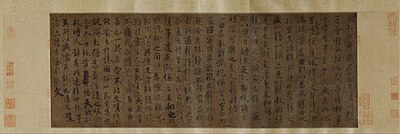

The Tang period was a golden age of Chinese literature and art. Over 48,900 poems penned by some 2,200 Tang authors have survived to the present day.[234][235] Skill in the composition of poetry became a required study for those wishing to pass imperial examinations,[236] while poetry was also heavily competitive; poetry contests amongst guests at banquets and courtiers were common.[237] Poetry styles that were popular in the Tang included gushi and jintishi, with the renowned poet Li Bai (701–762) famous for the former style, and poets like Wang Wei (701–761) and Cui Hao (704–754) famous for their use of the latter. Jintishi poetry, or regulated verse, is in the form of eight-line stanzas or seven characters per line with a fixed pattern of tones that required the second and third couplets to be antithetical (although the antithesis is often lost in translation to other languages).[238] Tang poems remained popular and great emulation of Tang era poetry began in the Song dynasty; in that period, Yan Yu (嚴羽; active 1194–1245) was the first to confer the poetry of the High Tang (c. 713–766) era with "canonical status within the classical poetic tradition." Yan Yu reserved the position of highest esteem among all Tang poets for Du Fu (712–770), who was not viewed as such in his own era, and was branded by his peers as an anti-traditional rebel.[239]
The Classical Prose Movement was spurred in large part by the writings of Tang authors Liu Zongyuan (773–819) and Han Yu (768–824). This new prose style broke away from the poetry tradition of the piantiwen (駢體文, "parallel prose") style begun in the Han dynasty. Although writers of the Classical Prose Movement imitated piantiwen, they criticized it for its often vague content and lack of colloquial language, focusing more on clarity and precision to make their writing more direct.[240] This guwen (archaic prose) style can be traced back to Han Yu, and would become largely associated with orthodox Neo-Confucianism.[241]
Short story fiction and tales were also popular during the Tang, one of the more famous ones being Yingying's Biography by Yuan Zhen (779–831), which was widely circulated in his own time and by the Yuan dynasty (1279–1368) became the basis for plays in Chinese opera.[242][243] Timothy C. Wong places this story within the wider context of Tang love tales, which often share the plot designs of quick passion, inescapable societal pressure leading to the abandonment of romance, followed by a period of melancholy.[244] Wong states that this scheme lacks the undying vows and total self-commitment to love found in Western romances such as Romeo and Juliet, but that underlying traditional Chinese values of inseparableness of self from one's environment (including human society) served to create the necessary fictional device of romantic tension.[245]

There were large encyclopedias published in the Tang. The Yiwen Leiju encyclopedia was compiled in 624 by the chief editor Ouyang Xun (557–641) as well as Linghu Defen (582–666) and Chen Shuda (d. 635). The encyclopedia Treatise on Astrology of the Kaiyuan Era was fully compiled in 729 by Gautama Siddha (fl. 8th century), an ethnic Indian astronomer, astrologer, and scholar born in the capital Chang'an.
Chinese geographers such as Jia Dan wrote accurate descriptions of places far abroad. In his work written between 785 and 805, he described the sea route going into the mouth of the Persian Gulf, and that the medieval Iranians (whom he called the people of Luo-He-Yi) had erected 'ornamental pillars' in the sea that acted as lighthouse beacons for ships that might go astray.[246] Confirming Jia's reports about lighthouses in the Persian Gulf, Arabic writers a century after Jia wrote of the same structures, writers such as al-Mas'udi and al-Muqaddasi. The Tang dynasty Chinese diplomat Wang Xuance traveled to Magadha (modern northeastern India) during the 7th century.[247] Afterwards he wrote the book Zhang Tianzhu Guotu (Illustrated Accounts of Central India), which included a wealth of geographical information.[248]
Many histories of previous dynasties were compiled between 636 and 659 by court officials during and shortly after the reign of Emperor Taizong of Tang. These included the Book of Liang, Book of Chen, Book of Northern Qi, Book of Zhou, Book of Sui, Book of Jin, History of Northern Dynasties and the History of Southern Dynasties. Although not included in the official Twenty-Four Histories, the Tongdian and Tang Huiyao were nonetheless valuable written historical works of the Tang period. The Shitong written by Liu Zhiji in 710 was a meta-history, as it covered the history of Chinese historiography in past centuries until his time. The Great Tang Records on the Western Regions, compiled by Bianji, recounted the journey of Xuanzang, the Tang era's most renowned Buddhist monk.
Other important literary offerings included Duan Chengshi's (d. 863) Miscellaneous Morsels from Youyang, an entertaining collection of foreign legends and hearsay, reports on natural phenomena, short anecdotes, mythical and mundane tales, as well as notes on various subjects. The exact literary category or classification that Duan's large informal narrative would fit into is still debated amongst scholars and historians.[249]
Religion and philosophy
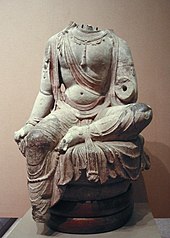
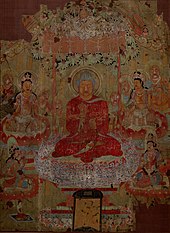
Since ancient times, some Chinese had believed in folk religion and Taoism that incorporated many deities. Practitioners believed the Tao and the afterlife was a reality parallel to the living world, complete with its own bureaucracy and afterlife currency needed by dead ancestors.[250] Funerary practices included providing the deceased with everything they might need in the afterlife, including animals, servants, entertainers, hunters, homes, and officials. This ideal is reflected in Tang dynasty art.[251] This is also reflected in many short stories written in the Tang about people accidentally winding up in the realm of the dead, only to come back and report their experiences.[250]
Buddhism, originating in India around the time of Confucius, continued its influence during the Tang period and was accepted by some members of imperial family, becoming thoroughly sinicized and a permanent part of Chinese traditional culture. In an age before Neo-Confucianism and figures such as Zhu Xi (1130–1200), Buddhism had begun to flourish in China during the Northern and Southern dynasties, and became the dominant ideology during the prosperous Tang. Buddhist monasteries played an integral role in Chinese society, offering lodging for travelers in remote areas, schools for children throughout the country, and a place for urban literati to stage social events and gatherings such as going-away parties.[252] Buddhist monasteries were also engaged in the economy, since their land property and serfs gave them enough revenues to set up mills, oil presses, and other enterprises.[253][254][255] Although the monasteries retained 'serfs', these monastery dependents could actually own property and employ others to help them in their work, including their own slaves.[256]
The prominent status of Buddhism in Chinese culture began to decline as the dynasty and central government declined as well during the late 8th century to 9th century. Buddhist convents and temples that were exempt from state taxes beforehand were targeted by the state for taxation. In 845 Emperor Wuzong of Tang finally shut down 4,600 Buddhist monasteries along with 40,000 temples and shrines, forcing 260,000 Buddhist monks and nuns to return to secular life;[257][258] this episode would later be dubbed one of the Four Buddhist Persecutions in China. Although the ban was lifted just a few years after, Buddhism never regained its once dominant status in Chinese culture.[257][258][259][260] This situation also came about through a revival of interest in native Chinese philosophies such as Confucianism and Taoism. Han Yu (786–824)—who Arthur F. Wright stated was a "brilliant polemicist and ardent xenophobe"—was one of the first men of the Tang to denounce Buddhism.[261] Although his contemporaries found him crude and obnoxious, he foreshadowed the later persecution of Buddhism in the Tang, as well as the revival of Confucian theory with the rise of Neo-Confucianism of the Song dynasty.[261] Nonetheless, Chán Buddhism gained popularity amongst the educated elite.[257] There were also many famous Chan monks from the Tang era, such as Mazu Daoyi, Baizhang, and Huangbo Xiyun. The sect of Pure Land Buddhism initiated by the Chinese monk Huiyuan (334–416) was also just as popular as Chan Buddhism during the Tang.[262]
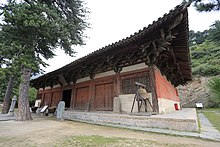
Rivaling Buddhism was Taoism, a native Chinese philosophical and religious belief system that found its roots in the Tao Te Ching and the Zhuangzi. The ruling Li family of the Tang dynasty actually claimed descent from Laozi, traditionally credited as the author of the Tao Te Ching.[264] On numerous occasions where Tang princes would become crown prince or Tang princesses taking vows as Taoist priestesses, their lavish former mansions would be converted into Taoist abbeys and places of worship.[264] Many Taoists were associated with alchemy in their pursuits to find an elixir of immortality and a means to create gold from concocted mixtures of many other elements.[265] Although they never achieved their goals in either of these futile pursuits, they did contribute to the discovery of new metal alloys, porcelain products, and new dyes.[265] The historian Joseph Needham labeled the work of the Taoist alchemists as "protoscience rather than pseudoscience."[265] However, the close connection between Taoism and alchemy, which some sinologists have asserted, is refuted by Nathan Sivin, who states that alchemy was just as prominent (if not more so) in the secular sphere and practiced more often by laymen.[266]
The Tang dynasty also officially recognized various foreign religions. The Assyrian Church of the East, otherwise known as the Nestorian Church or the Church of the East in China, was given recognition by the Tang court. In 781, the Nestorian Stele was created in order to honor the achievements of their community in China. A Christian monastery was established in Shaanxi province where the Daqin Pagoda still stands, and inside the pagoda there is Christian-themed artwork. Although the religion largely died out after the Tang, it was revived in China following the Mongol invasions of the 13th century.[267]
Although the Sogdians had been responsible for transmitting Buddhism to China from India during the 2nd to 4th centuries, soon afterwards they largely converted to Zoroastrianism due to their links to Sassanid Persia.[268] Sogdian merchants and their families living in cities such as Chang'an, Luoyang, and Xiangyang usually built a Zoroastrian temple once their local communities grew larger than 100 households.[269] Sogdians were also responsible for spreading Manicheism in Tang China and the Uighur Khaganate. The Uighurs built the first Manichean monastery in China in 768, yet in 843 the Tang government ordered that the property of all Manichean monasteries be confiscated in response to the outbreak of war with the Uighurs.[270] With the blanket ban on foreign religions two years later, Manicheism was driven underground and never flourished in China again.[271]
Leisure
More than earlier periods, the Tang era was renowned for the time reserved for leisure activities, especially among the upper classes.[272] Many outdoor sports and activities were enjoyed during the Tang, including archery,[273] hunting,[274] horse polo,[275] cuju (soccer),[276] cockfighting,[277] and even tug of war.[278] Government officials were granted vacations during their tenure in office. Officials were granted 30 days off every three years to visit their parents if they lived 1,000 mi (1,600 km) away, or 15 days off if the parents lived more than 167 mi (269 km) away (travel time not included).[272] Officials were granted nine days of vacation time for weddings of a son or daughter, and either five, three, or one days/day off for the nuptials of close relatives (travel time not included).[272] Officials also received a total of three days off for their son's capping initiation rite into manhood, and one day off for the ceremony of initiation rite of a close relative's son.[272]

Traditional Chinese holidays such as Chinese New Year, Lantern Festival, Cold Food Festival, and others were universal holidays. In Chang'an, there was always lively celebration, especially for the Lantern Festival since the city's nighttime curfew was lifted by the government for three days straight.[279] Between the years 628 and 758, the imperial throne bestowed a total of sixty-nine grand carnivals nationwide, granted by the emperor in the case of special circumstances such as important military victories, abundant harvests after a long drought or famine, the granting of amnesties, or the installment of a new crown prince.[280] For special celebration in the Tang era, lavish and gargantuan-sized feasts were sometimes prepared, as the imperial court had staffed agencies to prepare the meals.[281] This included a prepared feast for 1,100 elders of Chang'an in 664, a feast held for 3,500 officers of the Divine Strategy Army in 768, and one in 826 for 1,200 members of the imperial family and women of the palace.[281] Alcohol consumption was a prominent facet of Chinese culture; people during the Tang drank for nearly every social event.[282] An 8th-century court official allegedly had a serpent-shaped structure called the 'ale grotto' built on the ground floor using a total of 50,000 bricks, which featured bowls from which each of his friends could drink.[283]
Status in clothing
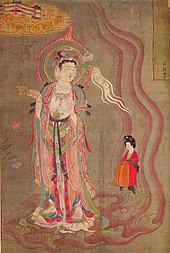
In general, garments were made from silk, wool, or linen depending on your social status and what you could afford. Furthermore, there were laws that specified what kinds of clothing could be worn by whom. The color of the clothing also indicated rank. During this period, China's power, culture, economy, and influence were thriving. As a result, women could afford to wear loose-fitting, wide-sleeved garments. Even lower-class women's robes had sleeves four to five feet wide.[284]
Position of women

Concepts of women's social rights and social status during the Tang era were notably liberal-minded for the period. However, this was largely reserved for urban women of elite status, as men and women in the rural countryside labored hard in their different set of tasks; with wives and daughters responsible for more domestic tasks of weaving textiles and rearing of silk worms, while men tended to farming in the fields.[118]There were many women in the Tang era who gained access to religious authority by taking vows as Taoist priestesses.[264]
In Chang'an, ordinary courtesans inhabited the North Hamlet.[285] They were generally knowledgeable in the rules of drinking games, and received particular training in table manners.[286] While renowned for their politeness, courtesans were reputed to dominate conversations among elite men, and as being unafraid to openly criticize the rudeness of prominent male guests, including for talking too much, too loudly, or for boasting of their accomplishments.[287]Courtesans were sometimes beaten by their procuring madames.[288]
Gējìs, or professional singing courtesans, were culturally prominent, and joined talent agencies called Jiaofang.[289] The emperor selected particularly talented women from the outer jiaofang to form the spring court, who were supplemented by courtesans from other troupes.[290] During the Tang Dynasty, singing courtesans who were also talented in the poetry.[291] In addition to singing, some courtesans composed their own songs, and even popularized a new form of lyrical verse that incorporated quotations of famous historical figures.[234]
It was fashionable for women to have full figures; men enjoyed the presence of assertive, active women.[292][293] The foreign horse-riding sport of polo from Persia became a wildly popular trend among the Chinese elite, and women often played the sport (as glazed earthenware figurines from the time period portray).[292] The preferred hairstyle for women was to bunch their hair up like "an elaborate edifice above the forehead",[293] while affluent ladies wore extravagant head ornaments, combs, pearl necklaces, face powders, and perfumes.[294] A 671 law attempted to force women to wear hats with veils again in order to promote decency, but these laws were ignored as some women started wearing caps and even no hats at all, as well as men's riding clothes and boots, and tight-sleeved bodices.[295]
There were some prominent court women after the era of Empress Wu, such as Yang Guifei (719–756), who had Emperor Xuanzong appoint many of her relatives and cronies to important ministerial and martial positions.[50]
Cuisine

During the earlier Northern and Southern dynasties (420–589), and perhaps even earlier, the drinking of tea (Camellia sinensis) became popular in southern China. Tea was viewed then as a beverage of tasteful pleasure and with pharmacological purpose as well.[234] During the Tang dynasty, tea became synonymous with everything sophisticated in society. The poet Lu Tong (790–835) devoted most of his poetry to his love of tea. The 8th-century author Lu Yu (known as the Sage of Tea) even wrote a treatise on the art of drinking tea, called The Classic of Tea.[296] Although wrapping paper had been used in China since the 2nd century BC,[297] during the Tang dynasty the Chinese were using wrapping paper as folded and sewn square bags to hold and preserve the flavor of tea leaves.[297] This followed many other uses for paper such as the first recorded use of toilet paper made in 589 by the scholar-official Yan Zhitui (531–591),[298] confirmed in 851 by an Arab traveler who remarked that Tang Chinese lacked cleanliness because they relied on toilet paper instead of washing themselves with water.[298]
In ancient times, the Chinese had outlined the five most basic foodstuffs known as the five grains: sesamum, legumes, wheat, panicled millet, and glutinous millet.[299] The Ming dynasty encyclopedist Song Yingxing noted that rice was not counted amongst the five grains from the time of the legendary and deified Chinese sage Shennong (the existence of whom Yingxing wrote was "an uncertain matter") into the 2nd millenniums BC, because the properly wet and humid climate in southern China for growing rice was not yet fully settled or cultivated by the Chinese.[299] Song Yingxing also noted that in the Ming dynasty, seven tenths of civilians' food was rice. During the Tang dynasty rice was not only the most important staple in southern China, but had also become popular in the north where central authority resided.[300]
During the Tang dynasty, wheat replaced the position of millet and became the main staple crop. As a consequence, wheat cake shared a considerable amount in the staple of Tang.[301] There were four main kinds of cake: steamed cake, boiled cake, pancake, and Hu cake. Steamed cake was consumed commonly by both civilians and aristocrats. Like rougamo in modern Chinese cuisine, steamed cake was usually stuffed with meat and vegetables. Shops and packmen regularly sold inexpensive steamed cake on the streets of Chang’an.[302] Boiled cake was the staple of the Northern Dynasties, and it kept its popularity in the Tang dynasty. It included a wide variety of dishes similar to modern wonton, noodles, and many other kinds of food that soak wheat in water. While aristocrats favored wonton, civilians usually consumed noodles and noodle slice soup that were easier to produce.[303] Pancakes was rare in China before the Tang, when it gained popularity.[304] Food shops in Tang cities such as Chang'an commonly sold both pancakes and dumplings.[302] Hu cake, which means "foreign cake", was extremely popular during the Tang.[305] Hu cake was toasted in the oven, covered with sesame seeds, and served at taverns, inns and shops. Japanese Buddhist monk Ennin observed that Hu cake was popular among all of China's civilians.[306]
Во время запаха много распространенных продуктов питания и ингредиентов для приготовления пищи в дополнение к уже перечисленным, были ячмень, чеснок, соль, репа, соевые бобы, груши, абрикосы, персики, яблоки, гранаты, джиубес, ревень, оправку, пряные орехи, каштаны, ореховые орехи, рев. , Ямс, Таро и т . Д. предпочтительный на севере), морской выдр , медведь (которого было трудно поймать, но были рецепты для приготовленного на пару, вареного и маринованного медведя) и даже бактрийских верблюдов . [307] На юге вдоль мяса побережья из морепродуктов было по умолчанию наиболее распространенным, так как китайцы с удовольствием ели приготовленную медузу с корицей , сичуанским перцем , кардамоном и имбирем , а также устрицами с вином, жареными кальмарами с имбирем и уксусом, крабами подковы. и красные плавательные крабы , креветки и рыба -пуфер , которые китайцы называли «речной порошкой». [ 308 ]
Из торговли за рубежом и по земле китайцы приобрели персики у Самарканда , даты ладони, фисташки и инжира из большего Ирана , кедровых орехов и женьшеня корней из Кореи и манго из Юго -Восточной Азии . [ 309 ] [ 310 ] В Китае был большой спрос на сахар; Во время правления Харши над Северной Индией (р. 606–647) индийские посланники в Тан привели двух производителей сахара, которые успешно научили китайцев развивать сахарный тростник . [ 311 ] [ 312 ] Коттон также приехал из Индии в качестве готового продукта из Бенгалии , хотя именно во время запаса китайцы начали расти и обрабатывают хлопок, а династией Юаней он стал главной текстильной тканью в Китае. [ 313 ]
Некоторые продукты также были без ограничений , так как суд побудил людей не есть говядину . Это было связано с ролью быка как ценного рабочего животного . С 831 по 833 Император Вензонг из Тан даже запретил убивать крупного рогатого скота на основании своих религиозных убеждений по поводу буддизма . [ 314 ]
Методы сохранения продуктов питания были важны и практиковались по всему Китаю. Обычные люди использовали простые методы сохранения, такие как копание глубоких каналов и траншей, раскатывание и солирование пищи. [ 315 ] У императора были большие ледяные ямы, расположенные в парках в Чангане и его окрестностях, для сохранения пищи, в то время как богатая и элита были свои более мелкие ледяные ямы. Каждый год император заставлял рабочих на 1000 блоков льда из замороженных ручьев в горных долинах, каждый блок с размером 3 фута (0,91 м) на 3 фута на 3,5 фута (1,1 м). Замороженные деликатесы, такие как охлажденная дыня, наслаждались летом. [ 316 ]
-
чаша эпоха Позолоченная с лотосом и мотивами животных
-
Блюдо с лопастикой с заглушением с зарегистрированными украшениями, 8 -й век.
-
Гробница фигуры с 7–8 -го века леди -помощника в эпоху Тан. Женщины -хозяева подготовили праздники, чайные вечеринки и играли в пьющие игры со своими гостями
-
Окруженная «предложение» с дизайном в «Три цвета» ( Sancai ) глазурь, 8 -й век
Наука и техника
Инженерный
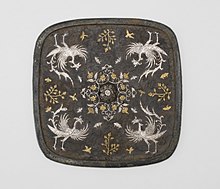
Технология в течение периода тана была построена также на прецедентах прошлого. Предыдущие достижения в области часов и хронометражных систем, включающих механические системы передачи Чжан Хенг (78–139) и ман Джун (Fl. 3 -й век), который дал вдохновлению математика, инженера -механика, астронома и монаха Yi Xing (683–727). Когда он изобрел первый в мире механизм снимания по часу в 725 году. [ 317 ] Это использовалось вместе с часами Clepsydra и водяным колесом для прикрепления вращающейся армиллярной сферы в представлении астрономического наблюдения. [ 318 ] Устройство Yi Xing также имело механически временный колокол, который был автоматически поражен каждый час, и барабан, который был автоматически поражен каждые четверть часа; По сути, поразительные часы . [ 319 ] Йи Син Астрономические часы и армиллярную сферу, проведенные водяными, стали хорошо известны по всей стране, поскольку студенты, пытающиеся сдать имперские экзамены на 730, должны были написать эссе на устройстве в качестве требования к экзамену. [ 320 ] Тем не менее, наиболее распространенным типом общественного и дворцового хронометража была приток Clepsydra. Его дизайн был улучшен в. 610 от инженеров Sui-Dynasty Geng Xun и Yuwen Kai. Они обеспечили баланс Steelyard , который позволил сезонную регулировку в головке давления компенсационного резервуара, а затем могли контролировать скорость потока в течение разных днем и ночи. [ 321 ]
В эпоху Тан было много других механических изобретений. Они включали в себя 3 -футовый (0,91 м) механический винный сервер начала 8 -го века, который находился в форме искусственной горы, вырезанной из железа и покоился на раме черепахи с лаком -деревом. В этом замысловатом устройстве использовался гидравлический насос, который вытащил вино из металлических драконов , а также наклонные миски, которые были рассчитаны на то, чтобы опустить вино, силой гравитации , когда наполнится, в искусственное озеро, у которого были сложные железные листья, появляющиеся как листья. подносы для размещения вечеринок. [ 322 ] Кроме того, как описывает историк Чарльз Бенн:
На полпути вверх по южной стороне горы был дракон ... Зверь открыл рот и выпил в купетку, сидящий на большом листье лотоса [железа]. Когда чашка была заполнена на 80%, дракон перестал извергать эль, и гость сразу же захватил кубок. Если он медленно слил чашку и возвращал ее в лист, дверь павильона на вершине горы открылась и механический винный сервер, одетый в кепку и платье, появилась с деревянной летучей мышью в руке. Как только гость вернул кубок, дракон наполнил его, винный сервер вышел, и двери павильона закрылись ... насос просеивал эль, который прошел в бассейн эля через скрытую дыру и вернул варево в Водохранилище [держит более 16 литров/15 литров вина] внутри горы. [ 322 ]
Тем не менее, использование дразнящей механической марионетки в этом устройстве, обслуживающем вино, было не совсем новым изобретением танга, поскольку использование механических марионеток в Китае датируется династией Цинь (221–207 до н.э.). В 3 -м веке у мсюна была целый механический марионеток, управляемый вращением водяного колеса. [ 323 ] Был также автоматический винный сервер, известный в древнем греко-римском мире, дизайне греческого изобретателя Херона Александрии , в котором использовалась урна с внутренним клапаном и рычажным устройством, аналогичным описанному выше. Есть много историй об автоматах , используемых в Tang, в том числе деревянная статуя монаха генерала Вулиана о монахе, который вытянул руки, чтобы собрать вклад; Когда количество монет достигло определенного веса, механическая фигура переместил его руки, чтобы положить их в расту. [ 324 ] Этот механизм веса и рычага был точно таким же, как пенни- игровой автомат Херона . [ 325 ] Другие устройства включали один от Ван Джу, чья «деревянная выдр» якобы мог поймать рыбу; Нидхэм подозревает, что ловушка . здесь работала весенняя [ 324 ]
В сфере структурной инженерии и технической китайской архитектуры были также правительственные стандартные строительные нормы, изложенные в ранней книге Tang of Yingshan Ling (национальный строительный закон). [ 326 ] Фрагменты этой книги выжили в Tang Lü (Tang Code), [ 327 ] В то время как архитектурное руководство Dynasty The Yingzao Fashi (государственные строительные стандарты) Ли Цзе (1065–1101) в 1103 году является самым старым существующим техническим трактатом о китайской архитектуре, который выжил полностью. [ 326 ] Во время правления Императора Сюанзонга Тан (712–756) было 34 850 зарегистрированных мастеров , обслуживающих штат, управляемые агентством дворцов зданий (Jingzuo jian). [ 327 ]
Печата дерева

Печата Woodblock сделала письменное слово доступным для чрезвычайно большей аудитории. Одним из старейших в мире выживших печатных документов является миниатюрный буддийский дхарани Сутра, обнаружившаяся в Сиане в 1974 году и датируется примерно с 650 до 670. [ 328 ] Diamond Sutra -это первая полноразмерная книга, напечатанная при регулярном размере, в комплекте с иллюстрациями, встроенными с текстом и датированной именно 868. [ 329 ] [ 330 ] Среди самых ранних документов были напечатаны буддийские тексты, а также календари, последние, необходимые для расчета и маркировки, какие дни были благоприятными, а какие - нет. [ 331 ] Поскольку так много книг, входящих в циркуляцию для широкой публики, уровень грамотности может улучшиться, наряду с тем, что низшие классы могут получить более дешевые источники обучения. Следовательно, было больше более низкого класса, которые попадали в имперские экзамены и проходили их более поздней династией. [ 107 ] [ 332 ] [ 333 ] Хотя более поздняя Би -Шенга в печать типа 11 -м веке была инновационной в течение его периода, тип дерева, которая стала широко распространенной в Tang, оставалась доминирующей типом печати в Китае до тех пор, пока более продвинутая печатная станка не стала широко распространенной и использованной на востоке Азия. [ 334 ] Первым использованием игровой карты во время династии Тан было вспомогательным изобретением новой эры печати. [ 335 ]
Картография
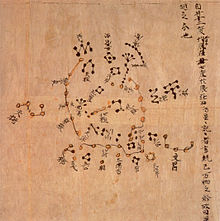
В сфере картографии произошли дальнейшие достижения за пределами карт династии Хань. Когда канцлер Tang Pei Ju (547–627) работал на династию SUI в качестве коммерческого комиссара в 605 году, он создал известную карту сетки с градуированной шкалой в традиции Pei Xiu (224–271). [ 338 ] Канцлер Тан Сюй Цзинзонг (592–672) был также известен своей картой Китая, нарисованной в 658 году. [ 339 ] В 785 году император Дезонг имел географ и картограф Цзя Дэн (730–805) завершить карту Китая и ее бывшие колонии в Центральной Азии. [ 339 ] После его завершения в 801 карта составляла 9,1 м (30 футов) по длине и 10 м (33 фута) в высоту, нанесенная на карту по шкале сетки в один дюйм, равного сто LI (китайская единица расстояния измерения). [ 339 ] Китайская карта 1137 года по сложности схожа с тем, что было сделано Цзя Дэн, вырезанной на каменной стеле со сеткой 100 LI. [ 340 ] Тем не менее, единственный тип карты, который выжил от периода Tang, - это звездные карты . Несмотря на это, самые ранние существующие карты местности Китая происходят из древнего государства Цинь ; Карты 4 -го века до нашей эры, которые были раскопаны в 1986 году. [ 341 ]
Лекарство
Китайцы эпохи Тан интересовались преимуществами официальной классификации лекарств, используемых в фармакологии . В 657 году Император Газозонг из Танга (р. 649–683) заказал официальную Materia Medica , в комплекте с текстом и иллюстрированными чертежами для 833 различных лекарственных веществ. [ 342 ] В дополнение к составлению фармакопеи, TANCE способствовал обучению в медицине, поддерживая имперские медицинские колледжи, государственные экзамены для врачей и публикацию судебных руководств для врачей. [ 313 ] Авторы медицины в Tang включают Чжэнь Чуан (ум. 643) и Sun Simiao (581–682); Первый был первым в письменной форме, что у пациентов с диабетом был избыток сахара в моче , а последние были первыми, кто признал, что пациенты с диабетом должны избегать употребления алкоголя и крахмалистых продуктов. [ 343 ] Как написано Чжэнь Чуан и другие в Tang, щитовидные железы овец и свиней были успешно использованы для лечения голубы ; Экстракты щитовидной железы не использовались для лечения пациентов с зобами на Западе до 1890 года. [ 344 ] Использование стоматологической амальгамы , изготовленной из TIN и Silver, впервые было введено в медицинский текст Xinxiu Bencao, написанный Su Gong в 659 году. [ 345 ]
Алхимия, газовые цилиндры и кондиционер
Китайские ученые периода Tang использовали сложные химические формулы для множества различных целей, часто встречающихся в экспериментах алхимии . Они включали в себя водонепроницаемый крем или лак или лак для одежды и оружия, огнеупорный цемент для стеклянных и фарфоровых товаров, водонепроницаемый крем, применяемый к шелковой одежде подводных дайверов , крем, предназначенный для полировки бронзовых зеркал и многие другие полезные формулы. [ 346 ] Прозрачная, полупрозрачная керамика, известная как фарфор, была изобретена в Китае во время тана, хотя многие виды застекленной керамики предшествовали ему. [ 218 ] [ 347 ]
Со времен Хана китайцы пробурили глубокие скважины для транспортировки природного газа из бамбуковых трубопроводов в печи, где чугунные кустения испарения кипятили рассол для извлечения соли. [ 348 ] Во время династии Тан в газетке из провинции Сычуань заявили, что на одном из этих 182 м (600 футов) «пожарных скважин» мужчины собрали природный газ в портативные бамбуковые трубки, которые можно было бы переносить на десятки километра (MI) и до сих пор производить пламя. [ 349 ] По сути, это были первые газовые цилиндры ; Роберт Темпл предполагает, что какой -то крав . для этого устройства использовался [ 349 ]
Изобретатель Дин Хуан ( Fl. 180 AD) династии Хань изобрел вращающийся вентилятор для кондиционирования воздуха . [ 350 ] В 747 году император Сюанзанг был построен в «прохладном зале» в Имперском дворце, который Тан Юлин ( 唐語林 唐語林 ) описывает как наличие вентиляционных колес с водными способностями для кондиционирования воздуха, а также восходящих струйных потоков воды из фонтанов. [ 351 ] Во время последующей династии песен письменные источники упоминали о роторном фанате как еще более широко используемый. [ 352 ]
Историография
Первая классическая работа о Tang - старая книга Tang от Liu Xu et al. более позднего Джина . Это было отредактировано в другую историю (помеченную новой книгой Тан ) историками песни Оуян Сю , Сонг Ци и др. Оба были основаны на более ранних летописях, теперь потерянные. [ 353 ] Они оба также входят в число двадцати четырех историй Китая. Одним из оставшихся в живых источниках старой книги Тан , в первую очередь, до 756 года, является Тонгдиан , который вы представили императору в 801 году. Период Tang был помещен в огромный универсальной истории текст 294-объема Zizhi Tongjian Отредактировано, скомпилировано и завершено в 1084 году командой ученых под канцлером династии Сонг Симой Гуанг . Этот исторический текст охватывал историю Китая с начала воюющих государств в 403 году до нашей эры до начала династии Сун в 960 году.
Примечания
- ^ Часто использовалась вежливая форма Dà Táng ( 大唐 , Lit. ' Great Tang ) , например, в именах книг периода. [ 7 ]
- ^ Во время правила TAG население мира выросло с 190 миллионов до 240 миллионов, разница в 50 миллионов. Смотрите также средневековую демографию .
- ^ Университет Фордхэма (2000) предлагает Фридриха Хирта отрывок (1885) из старой книги Тан : «Император Ян-ти династии Суй [605–617 гг переведенный . не . удалось Император 641–668 CE] послал посольство, предлагающее красное стекло, Lu-Chin-Ching [зеленое золото] и другие статьи . шелка . подарки Предоставлены осаждение их столицы; Ien-Feng [667 г. н.э.] они отправили посольство, предлагающее Ти-Йе-Ка. В первом месяце седьмого года периода К'Аи-Юань [719 г. н.э.] их лорд отправил та-то-кал [офицер высокого ранга] Т'У-хуо-Ло [Хазарстан] предложить львов и Линг-Ян [антилопы], два каждого. Через несколько месяцев он далее отправил в нашем дворе Ta-Te-Seng [«священники великой добродетели»].
Ссылки
Цитаты
- ^ Blunden & Elvin (1983) , стр. 26, 92–93.
- ^ Twitchett & Wechsler (1979) , p. 281.
- ^ Shin (2014) , с. 39, 47.
- ^ Турчин, Петр; Адамс, Джонатан М.; Холл, Томас Д (декабрь 2006 г.). «Восток-западный ориентация исторических империй» . Журнал исследований мировых систем . 12 (2): 222. ISSN 1076-156X .
- ^ Taagepera, Rein (1997). «Расширение и схема сжатия больших полиций: контекст для России» . Международные исследования ежеквартально . 41 (3): 492. doi : 10.1111/0020-8833.00053 . JSTOR 2600793 .
- ^ "Тан" . Рэндом Хаус Вебстерский словарь Вебстера .
- ^ Уилкинсон 2013 , с. 6
- ^ Льюис 2012 , с. 1
- ^ Jump up to: а беременный в дюймовый и фон глин час я Дж k л Ebrey, Walthall & Palais 2006 , p. 91
- ^ Ebrey 1999 , с. 111, 141.
- ^ Вы 1998 , с.
- ^ Fairbank & Goldman 2006 , p. 106
- ^ Yu 1998 , pp. 73–87.
- ^ Jump up to: а беременный Ebrey, Walthall & Palais 2006 , с. 90–91.
- ^ Adshead 2004 , с. 40–41.
- ^ Latourette 1934 , p. 191.
- ^ Drompp 2004 , p. 126
- ^ Drompp 2005 , p. 376.
- ^ Wechsler, Howard J. (1979). Sui and Tang China, 589–906. Часть 1 . Кембридж, Англия: издательство Кембриджского университета. п. 151. ISBN 978-1-139-05594-9 Полем
Эта генеалогия, утверждаемая Королевским домом Танга, установила свое требование о том, что он произошел от известного клана Хан и членами выдающегося северо-западного происхождения. Тем не менее, есть какие -то основания полагать, что эта линия спуска, представленная в истории Танга, была на самом деле преднамеренным изготовлением. ... двое из мужчин, которые, как было предложено, были среди предков Ли Ху [дедушка Ли Юань], были генералами Ли Чу-ку-па-па и Ли Ма-Те, чьи имена показывают, что они имели Либо принят, либо получила китайскую фамилию Ли, но сохранила инопланетян, возможно, Hsien-Pei , личные имена.
- ^ Чен, Санпинг (2012). Многокультурный Китай в раннем средневековье . Университет Пенсильвании Пресс. С. 4–6. ISBN 978-0-8122-0628-9 Полем
Более интересно, столкнувшись с противодействием судьям имперского суда, которые хотели поддерживать обязательную смертную казнь, Император Тайзонг объяснил, что клевета Фалина Королевского происхождения «не было без фундамента». Император Тайзонг, по -видимому, признал, что генеалогические связи Имперского клана с дворянами Туоба и другими «варварскими» семьями были открытыми современными знаниями ... новейшим доказательством является недавнее открытие, которое показывает, что еще один выдающийся клан LI, а именно : Сиан , главный генерал Северного Чжоу , с теми же претензиями на происхождение Лонгкси, на самом деле был безошибочный Туоба Сянбей спуск.
- ^ Получить 2012 , с.
- ^ Тоган 2011 , с. 177.
- ^ Как представлена эпитафией на крышке Шангуанского Ван'ера .
- ^ Graff 2000 , с. 78, 93.
- ^ Jump up to: а беременный Adshead 2004 , p. 40
- ^ Dig 2000 , p. 78
- ^ Dig 2000 , p. 80
- ^ Adshead 2004 , с. 40–42.
- ^ Graff 2000 , pp. 78, 82, 85–86, 95.
- ^ Jump up to: а беременный Adshead 2004 , p. 42
- ^ Jump up to: а беременный в дюймовый Ebrey, Walthall & Palais 2006 , p. 93.
- ^ Adshead 2004 , с. 42–43.
- ^ Jump up to: а беременный Twitchett 2000 , p. 124
- ^ Чжоу, Сюкин (Университет Пенсильвании) (апрель 2009 г.). «Чжаолинг: мавзолей императора Тан Тайзон» (PDF ) Кто-платонические документы 187 : 155. Архивировано (PDF) из оригинала 10 октября,
- ^ Jump up to: а беременный в дюймовый Ebrey, Walthall & Palais 2006 , p. 97
- ^ Ebrey, Walthall & Palais 2006 , с. 97–98.
- ^ Jump up to: а беременный в Ebrey, Walthall & Palais 2006 , p. 98
- ^ Возможно, 1988 , с. 234.
- ^ Jump up to: а беременный Marlowe 2008 , p. 64
- ^ "Zizhi Tongjian · Tang Ji · Двадцать два": Синхай, Мингтанг был завершен, 294 фута в высоту и 300 футов квадрат. Все три уровня: метод нижнего уровня составляет четыре сезона, каждый в соответствии с квадратным цветом. Средний метод - это двенадцать Чен; Верхний слой двадцати четырех ци также является круглой крышкой, с железным фениксом на нем, один Чжан высотой и украшенным золотом. В середине есть десять гигантских деревьев, которые проходят через верхнюю и нижнюю части, и на них основаны корни. Железный канал построен вниз, чтобы сформировать символ Biyong. Это называется дворец всех вещей.
- ^ Adshead 2004 , p. 45
- ^ Ebrey 1999 , p. 116
- ^ Сен 2003 , с. 97–98.
- ^ Уитфилд 2004 , с. 74
- ^ Fairbank & Goldman 2006 , p. 82
- ^ Jump up to: а беременный Schafer 1985 , p. 8
- ^ Kang 1999 , p. 12
- ^ Adshead 2004 , p. 46
- ^ Jump up to: а беременный Бенн 2002 , с. 6
- ^ Jump up to: а беременный в дюймовый Ebrey, Walthall & Palais 2006 , p. 99
- ^ Jump up to: а беременный Adshead 2004 , p. 47
- ^ Jump up to: а беременный в Бенн 2002 , с. 7
- ^ Бенн 2002 , с. 47
- ^ Adshead 2004 , p. 89
- ^ Adshead 2004 , с. 47–48.
- ^ Jump up to: а беременный в дюймовый и фон глин час я Дж Ebrey, Walthall & Palais 2006 , p. 100
- ^ Jump up to: а беременный Eberhard 2005 , p. 184.
- ^ Xu 1993 , pp. 455–467.
- ^ Jump up to: а беременный в дюймовый и фон Eberhard 2005 , p. 185.
- ^ Jump up to: а беременный Schafer 1985 , p. 9
- ^ Wan 2017 , p. 11
- ^ Qi 2010 , с. 221-227.
- ^ Его 2003 г. , с.
- ^ Gascoigne & Gascoigne 2003 , p. 97
- ^ Jump up to: а беременный Деньги 2003 , с. 91
- ^ Graff 2008 , с. 43–44.
- ^ Adshead 2004 , с. 90–91.
- ^ Jump up to: а беременный в дюймовый и Bowman 2000 , p. 105
- ^ Один 2002 , с. 15–17.
- ^ Jump up to: а беременный в Ebrey, Walthall & Palais 2006 , p. 101.
- ^ Fairbank & Goldman 2006 , p. 85
- ^ Adshead 2004 , p. 50
- ^ Needham 1986b , p. 347.
- ^ Один 2002 , с. 14–15.
- ^ Бенн 2002 , с. 15
- ^ Jump up to: а беременный в Adshead 2004 , p. 51
- ^ Jump up to: а беременный в Бенн 2002 , с. 16
- ^ Taenzer 2016 , с. 35–37.
- ^ Zizhi Tongjian , Vol .
- ^ Баумер 2012 , с. 310.
- ^ Eberhard 2005 , с. 189–190.
- ^ Гернет 1996 , с. 292
- ^ «Биографии истории пяти династий династии Тан»: « Чжуо Вузи прокомментировал:« Чжэн Синзонг оценил людей по его появлению, но потерял вора, заставив его убить восемь миллионов человек и провести кровь на три тысячи миль » "
- ^ Jump up to: а беременный Ebrey, Walthall & Palais 2006 , p. 108
- ^ Fashion 2003 , с. 6–7.
- ^ Scheidel, Walter (2018). Великий выравниватель. Насилие и история неравенства от каменного века до двадцать первого века . Принстон, Нью -Джерси: издательство Принстонского университета. С. 276–278. ISBN 978-0-691-18325-1 .
- ^ Fashion 2003 , с. 7-12.
- ^ Fashion 2003 , с. 6–7, 10, 12.
- ^ Jump up to: а беременный Fashion 2003 , с. 7, 10, 12.
- ^ Needham 1986c , с. 320–321, сноска H.
- ^ Мода 2003 , с.
- ^ Fashion 2003 , с. 10, 12–13.
- ^ Fashion 2003 , с. 10–11.
- ^ Fashion 2003 , с. 12–13.
- ^ Ebrey 1999 , с. 111–112.
- ^ Jump up to: а беременный в Ebrey 1999 , p. 112.
- ^ Andrew & Rapp 2000 , p. 25
- ^ Ebrey 1999 , p. 158
- ^ Бернхардт 1995 , с. 274–275.
- ^ Fairbank & Goldman 2006 , p. 78
- ^ Брук 1998 , с. 59
- ^ Бенн 2002 , с. 59
- ^ Jump up to: а беременный Ebrey, Walthall & Palais 2006 , с. 91–92.
- ^ Jump up to: а беременный в дюймовый Ebrey, Walthall & Palais 2006 , p. 92
- ^ Gascoigne & Gascoigne 2003 , p. 95
- ^ Fairbank & Goldman 2006 , p. 83.
- ^ Jump up to: а беременный Ebrey, Walthall & Palais 2006 , p. 159
- ^ Fairbank & Goldman 2006 , p. 95
- ^ Adshead 2004 , p. 54
- ^ Ebrey 1999 , pp. 145–146.
- ^ Dig 2000 , p. 79
- ^ Бенн 2002 , с. 61.
- ^ Бенн 2002 , с. 57
- ^ Ebrey 1999 , p. 141.
- ^ Nishijima 1986 , с. 595–596.
- ^ Adshead 2004 , p. 72
- ^ Бенн 2002 , с. 45
- ^ Jump up to: а беременный Бенн 2002 , с. 32
- ^ Adshead 2004 , p. 75
- ^ Ebrey, Walthall & Palais 2006 , p. 156
- ^ Один 2002 , с. 4
- ^ Jump up to: а беременный Уитфилд 2004 , с. 47
- ^ Twitchett 2000 , с. 116–118.
- ^ Twitchett 2000 , с. 118, 122.
- ^ Jump up to: а беременный Бенн 2002 , с. 9
- ^ Gift 2002 , P. 208
- ^ Gift 2002 , P. 209
- ^ Needham 1986c , с. 685–687.
- ^ Бенн 2002 , с. 4
- ^ Jump up to: а беременный Dig 2002 , p. 2011 год
- ^ Kang 2006 , p. 54
- ^ Kitagawa & Tsuchida 1975 , p.
- ^ Ebrey, Walthall & Palais 2006 , p. 144
- ^ Jump up to: а беременный Needham 1986b , p. 289
- ^ Needham 1986c , p. 308.
- ^ Reischauer 1940 , p. 152
- ^ Reischauer 1940 , p. 155
- ^ Ebrey, Walthall & Palais 2006 , p. 113.
- ^ XUE 1992 , с. 149–152, 257–264.
- ^ Один 2002 , с. 2–3.
- ^ Jump up to: а беременный Который 2005 , с. 655–659.
- ^ Jump up to: а беременный Ebrey 1999 , p. 111.
- ^ Xue 1992 , p. 788.
- ^ Jump up to: а беременный Twitchett 2000 , p. 125
- ^ Лю 2000 , стр. 85-95.
- ^ Гернет 1996 , с. 248
- ^ XUE 1992 , с. 226–227.
- ^ XUE 1992 , с. 380–386.
- ^ Бенн 2002 , с. 2
- ^ XUE 1992 , с. 222–225.
- ^ Получить 2009 , с.
- ^ Уитфилд 2004 , с. 193.
- ^ Sen 2003 , с. 24, 30–31.
- ^ Белл, Чарльз (1924). Тибетское прошлое и настоящее (RPR. Motilal Banarsidass, 1992 Ed.). Издательство Оксфордского университета. п. 28. ISBN 978-81-208-1048-8 Полем Получено 17 июля 2010 года .
- ^ Li, Tieh-tseng (lǐ tiězhēng 李鐵鐵鐵 ..... когда-либо) (1956). Исторический статус Тибета King's Crown Press, Колумбийский университет. П. 6
- ^ Беквит 1987 , с. 146
- ^ Stein 1972 , p. 65
- ^ Twitchett 2000 , p. 109
- ^ Jump up to: а беременный в дюймовый Бенн 2002 , с. 11
- ^ Ричардсон 1985 , с. 106–143.
- ^ Schafer 1985 , с. 10, 25–26.
- ^ Мухамад С. Олимат (2015). Китай и Азия в постсоветскую эпоху: двусторонний подход Lexington Books. Стр. 10–. ISBN 978-1-4985-1805-5 .
- ^ Литвинский, Б.А.; Джалилов, ах; Colesnikov, AI (1996). "Арабское завоевание " В Литвинском, Б.А. (ред.). История цивилизаций Центральной Азии, том III: перекресток цивилизаций: 250 г. н.э. Париж: UNESCO Publishing. Стр. 449–4 ISBN 978-92-3-103211-0 .
- ^ Bosworth, EC (1986). "Ḳutaya b. Муслим " В Босворте, ЕС ; Ван Донзел, Э .; Льюис, Б. и Пеллат, гл. (ред.). Энциклопедия Ислама, второе издание Том V: Хе - Махи . Лейден: EJ Brill. стр. 541–542. ISBN 978-90-04-07819-2 .
- ^ Гибб, Хар (1923). Арабские завоевания в Центральной Азии . Лондон: Королевское азиатское общество. С. 48 –51. OCLC 685253133 .
- ^ Shouyi et al. Bai , ISBN 978-78-101-02890-4 . Стр. 235-236
- ^ Кристофер И. Беквит (1993). Тибетская империя в Центральной Азии: история борьбы за великую власть среди тибетцев, турок, арабов и китайцев в раннем средневековье . ПРИЗНАЯ УНИВЕРСИТЕТА ПРИСЕТА. С. 88–89. ISBN 978-0-691-02469-1 .
- ^ Bai 2003 , стр. 242-243.
- ^ Eberhard 2005 , p. 183.
- ^ Fuller, Neathery Batsell (2002). «Краткая история бумаги» . Архивировано из оригинала 22 августа 2018 года . Получено 14 сентября 2016 года .
- ^ Schafer 1985 , p. 26
- ^ SK Sharma; Шарма, Уша (1996), Энциклопедия Тибета: история и география Тибета , Anmol Pub., P. 46, ISBN 978-81-7488-414-5 , получено 17 июля 2010 г.
- ^ Needham 1986b , p. 476.
- ^ Jump up to: а беременный Adshead 1995 , с. 104–106.
- ^ Jump up to: а беременный в Хирт, Фридрих (2000) [1885]. Джером С. Аркенберг (ред.). История Восточной Азии: китайские рассказы Рима, Византия и Ближний Восток, ок. 91 г. до н.э. « Университет Фордхэма . Архивировано с оригинала 10 сентября 2014 года . Получено 14 сентября 2016 года .
- ^ Jump up to: а беременный Yule 1915 , с. 54–55.
- ^ Adshead 1995 , p. 105
- ^ Ball 2016 , с. 152–153, см. EndNote 114.
- ^ Yule 1915 , с. 46–48.
- ^ Yule 1915 , с. 48–49.
- ^ Yule 1915 , с. 29–31.
- ^ Jump up to: а беременный Ebrey 1999 , p. 127
- ^ Ebrey 1999 , с. 118–119.
- ^ Ebrey 1999 , p. 119
- ^ Jump up to: а беременный в Ebrey, Walthall & Palais 2006 , p. 112.
- ^ Jump up to: а беременный Ebrey, Walthall & Palais 2006 , p. 114
- ^ Уитфилд 2004 , с. 255
- ^ Бенн 2002 , с. 134.
- ^ Schafer 1985 , p. 28
- ^ Eberhard 2005 , p. 182.
- ^ Adshead 2004 , p. 90
- ^ Twitchett 2000 , p. 118
- ^ Eberhard 2005 , p. 179
- ^ Сен 2003 , с. 30–32.
- ^ Уитфилд 2004 , с. 57, 228.
- ^ Эндрюс 2010 , с. 25
- ^ Sun 1989 , с. 161–167.
- ^ Chen 2002 , с. 67–71.
- ^ Боуман 2000 , с. 104–105.
- ^ Jump up to: а беременный в дюймовый Бенн 2002 , с. 46
- ^ Schafer 1985 , p. 20
- ^ Тан 1991 , с. 61.
- ^ Schafer 1985 , p. 15
- ^ Schafer 1985 , p. 16
- ^ Шен 1996 , с. 163.
- ^ Вудс 1996 , с. 143.
- ^ Schafer 1985 , с. 10, 16.
- ^ Eberhard 2005 , p. 190.
- ^ Jump up to: а беременный Schafer 1985 , p. 11
- ^ Reischauer 1940 , p. 157
- ^ Reischauer 1940 , p. 162.
- ^ Reischauer 1940 , с. 155–156.
- ^ «Сокровищница, делающая волны: Саймон Уорралл объясняет, почему недавнее открытие на морском дне Индийского океана будет революционизировать наше понимание двух древних цивилизаций» , BBC News , 18 октября 2008 г. , полученное 21 октября 2008 г.
- ^ Шен 1996 , с. 155
- ^ Jump up to: а беременный HSU 1988 , с. 96
- ^ Levathes 1994 , p. 38
- ^ Шен 1996 , с. 158
- ^ Jump up to: а беременный Adshead 2004 , p. 80
- ^ Jump up to: а беременный Лю 1991 , с.
- ^ MacGregor, Neil (2011). История мира в 100 объектах (первое американское изд.). Нью -Йорк: Viking Press . с. 351, 357. ISBN 978-0-670-02270-0 .
- ^ McMullen, David L. (1999). Макдермотт, Джозеф П. (ред.). Государственный и судный ритуал в Китае . Кембридж: издательство Кембриджского университета. п. 166. ISBN 978-0-521-62157-1 .
- ^ Ebrey, Walthall & Palais 2006 , p. 103
- ^ Один 2002 , с. что.
- ^ Бенн 2002 , стр. XIV, XV, XVI, XVII, XVIII.
- ^ Ю, Вейчао, изд. (1997). Путешествие в древность Китая . Пекин: издатели Morning Glory. п. 56. ISBN 978-7-5054-0507-3 .
- ^ Ebrey, Walthall & Palais 2006 , p. 79
- ^ Schafer 1985 , p. 21
- ^ Schafer 1985 , p. 25
- ^ Schafer 1985 , p. 22
- ^ Jump up to: а беременный в Schafer 1985 , с. 17–18.
- ^ Reischauer 1940 , с. 143–144.
- ^ Schafer 1985 , с. 18–19.
- ^ Schafer 1985 , с. 19–20.
- ^ Jump up to: а беременный в Ebrey 1999 , p. 120.
- ^ Harper 2005 , p. 33.
- ^ Бенн 2002 , с. 259
- ^ Бенн 2002 , с. 137.
- ^ Ebrey, Walthall & Palais 2006 , p. 102
- ^ Yu 1998 , pp. 75–76.
- ^ Ebrey, Walthall & Palais 2006 , p. 106
- ^ Huters 1987 , p. 52
- ^ Ebrey, Walthall & Palais 2006 , с. 104–105.
- ^ Вонг 1979 , с. 97
- ^ Вонг 1979 , с. 95–100.
- ^ Вонг 1979 , с. 98–99.
- ^ Needham 1986c , p. 661.
- ^ Sen 2003 , с. 9, 22–24.
- ^ Needham 1986a , p. 511.
- ^ Рид 2003 , с. 121.
- ^ Jump up to: а беременный Уитфилд 2004 , с. 333.
- ^ Эндрюс 2010 , с. 26
- ^ Ebrey 1999 , p. 121.
- ^ Ebrey 1999 , p. 122
- ^ Eberhard 2005 , p. 181.
- ^ Adshead 2004 , p. 86
- ^ Ebrey 1999 , p. 126
- ^ Jump up to: а беременный в Ebrey, Walthall & Palais 2006 , p. 96
- ^ Jump up to: а беременный Fairbank & Goldman 2006 , p. 86
- ^ Ebrey 1999 , p. 124
- ^ Harper 2005 , p. 34
- ^ Jump up to: а беременный Райт 1959 , с. 88
- ^ Ebrey 1999 , p. 123.
- ^ Steinhardt 2004 , с. 228–229.
- ^ Jump up to: а беременный в Бенн 2002 , с. 60
- ^ Jump up to: а беременный в Fairbank & Goldman 2006 , p. 81.
- ^ Сивин, Натан (1995), «Даосизм и наука» в области медицины, философии и религии в древнем Китае , Вариоруме, архивированы из оригинала 23 июня 2008 года , полученная 13 августа 2008 г.
- ^ Гернет 1962 , с. 215
- ^ Лю 2001 , с.
- ^ Говард 2012 , с. 134 .
- ^ Лю 2001 , стр. 168-69.
- ^ Лю 2001 , с.
- ^ Jump up to: а беременный в дюймовый Бенн 2002 , с. 149
- ^ Один 2002 , с. 39, 170.
- ^ Один 2002 , с. 22, 32.
- ^ Один 2002 , с. 16, 90.
- ^ Один 2002 , с. 151–152.
- ^ Один 2002 , с. 173–174.
- ^ Бенн 2002 , с. 152
- ^ Один 2002 , с. 150–154.
- ^ Один 2002 , с. 154–155.
- ^ Jump up to: а беременный Бенн 2002 , с. 132.
- ^ Один 2002 , с. 142–147.
- ^ Бенн 2002 , с. 143.
- ^ «Одежда династии Тан - факты о китайском платье Tang» . thetangdynasty.org . Получено 20 мая 2019 года .
- ^ Лара Кэролайн Уильямс Бланшар, 79.
- ^ Один 2002 , с. 64–66.
- ^ Бенн 2002 , с. 66
- ^ "Бейли Чжи" Солнца Ци династии Тан: девочки были нищими с детства, и некоторые из них были бедными семьями под своим родным городом. Часто есть нерегулярные люди, которые тайно ловят рыбу и охотятся, и есть также хорошие дети, которые нанимают их для своих семей, чтобы искать щедрые взятки. Если вы по ошибке попадете в это, вы не сможете сбежать. Если вы впервые научите песню и вините ее очень срочно, если вы немного вовлечены в отступление, вы сможете ее поднять. (Некоторые из этих девушек были Ггарсом, когда они были молодыми, а некоторые приходили из бедных семей. Часто были ненадлежащие люди, которые тайно продавали девочек братьев. Некоторые девушки из Будуара были женаты в таких семьях и продавали братьям по высоким ценам. Как только они оказались в ловушке, сначала не было возможности выйти Они были немного небрежными, они были бы взбиты кнутом.)
- ^ Бевели Бослер
- ^ Беверли Босслер, стр. 71-99 (29 страниц).
- ^ Лара Кэролайн Уильямс Бланшар, 119.
- ^ Jump up to: а беременный Ebrey 1999 , pp. 114–115.
- ^ Jump up to: а беременный Gernert 1962 , с. 165-166.
- ^ Гернет 1962 , с. 165.
- ^ Schafer 1985 , с. 28–29.
- ^ Ebrey 1999 , p. 95
- ^ Jump up to: а беременный Needham 1986d , p. 122
- ^ Jump up to: а беременный Needham 1986d , p. 123.
- ^ Jump up to: а беременный Песня 1966 , с. 3–4.
- ^ Ван Сайши 2003 , с.
- ^ Wang Saishi 2003 , p.
- ^ Jump up to: а беременный , Fang (1999) Li . [ ISBN отсутствует ] [ страница необходима ]
- ^ Ван Сайши 2003 , с.
- ^ Цзя, Junxia (2009). «Анализ пищи торта Чангана в династии Хана и Тан». Tangdu Journal . 25
- ^ Wang Saishi 2003 , p.
- ^ Эннин. Дневник Эннина: запись паломничества в Китай в поисках закона . Тол. 3
- ^ Бенн 2002 , с. 120.
- ^ Бенн 2002 , с. 121.
- ^ Бенн 2002 , с. 123.
- ^ Schafer 1985 , с. 1–2.
- ^ Sen 2003 , с. 38–40.
- ^ Adshead 2004 , с. 76, 83–84.
- ^ Jump up to: а беременный Adshead 2004 , p. 83.
- ^ Бенн 2002 , с. 125
- ^ Один 2002 , с. 126–127.
- ^ Бенн 2002 , с. 126
- ^ Needham 1986a , p. 319
- ^ Needham 1986b , pp. 473–475.
- ^ Needham 1986b , pp. 473–474.
- ^ Needham 1986b , p. 475.
- ^ Needham 1986b , p. 480.
- ^ Jump up to: а беременный Бенн 2002 , с. 144
- ^ Needham 1986b , p. 158
- ^ Jump up to: а беременный Needham 1986b , p. 163.
- ^ Needham 1986b , p. 163 Сноска c.
- ^ Jump up to: а беременный Guo 1998 , p.
- ^ Jump up to: а беременный Guo 1998 , p.
- ^ Pan 1997 , с. 979-980.
- ^ Храм 1986 , с. 112.
- ^ Needham 1986d , p. 151.
- ^ Ebrey 1999 , pp. 124–125.
- ^ Fairbank & Goldman 2006 , p. 94
- ^ Ebrey 1999 , p. 147
- ^ Needham 1986d , p. 227
- ^ Needham 1986d , pp. 131–132.
- ^ XI 1981 , с. 464.
- ^ Bonnet-bidaud, JM ; Прадери, Франсуаза; Уитфилд, С. «Китайское небо Дунхуанг: всестороннее исследование самой старой известной звезды Атлас» . Международный проект Dunhuang, Британская библиотека. Архивировано с оригинала 2 апреля 2014 года . Получено 13 марта 2015 года .
- ^ Needham 1986a , стр. 538–540, 543.
- ^ Jump up to: а беременный в Needham 1986a , p. 543.
- ^ Needham 1986 , p. Тарелка 81.
- ^ HSU 1993 , с. 90
- ^ Бенн 2002 , с. 235.
- ^ Храм 1986 , с. 132–133.
- ^ Храм 1986 , с. 134–135.
- ^ Czarnetzki, A.; Эрхардт С. (1990). «Переоснащение китайской амальгамы зубов в Европе». Международный журнал антропологии . 5 (4): 325–332.
- ^ Needham 1986e , p. 452.
- ^ Вуд 1999 , с. 49
- ^ Храм 1986 , с. 78–79.
- ^ Jump up to: а беременный Храм 1986 , с. 79–80.
- ^ Needham 1986b , pp. 99, 151, 233.
- ^ Needham 1986b , pp. 134, 151.
- ^ Needham 1986b , p. 151.
- ^ Денис Криспин Твитчетт (1992). Написание официальной истории под Тангом . Издательство Кембриджского университета. ISBN 978-0-521-41348-0 .
Работы цитируются
- Adshead, Sam (1995) [1988], Китай в мировой истории (2 -е изд.), Нью -Йорк: Palgrave Macmillan, ISBN 978-0-333-62132-5
- ——— (2004), Тан, Китай: рост Востока в мировой истории , Нью -Йорк: Пальгрейв Макмиллан, ISBN 978-1-4039-3456-7
- Эндрю, Анита Н.; Рапп, Джон А. (2000), «Автократное и мятежное» Императоры -основатели Китая: сравнение председателя Мао и Мин Тайзу , Ланхэм, доктор медицинских наук: Роуман и Литтлфилд, ISBN 978-0-8476-9580-5
- Эндрюс, Гейл С. (2010), Бирмингемский музей искусств: путеводитель по коллекции , Бирмингем, Алабама: Бирмингемский музей искусств, ISBN 978-1-904832-77-5
- Bai, Shouyi (2003), Национальная история Китая Хуи и Хуи [ История китайских мусульман ] (на китайском языке), вып. 2, Пекин: книжная компания Zhonghua, ISBN 978-7-101-02890-4
- Ball, Warwick (2016), Рим на Востоке: трансформация империи (2 -е изд.), Лондон: Routledge, ISBN 978-0-415-72078-6
- Baumer, Christoph (2012), История Центральной Азии: эпоха Степи -Воинов
- Беквит, Кристофер И. (1987), Тибетская империя в Центральной Азии , издательство Принстонского университета, ISBN 978-0-691-02469-1
- Бенн, Чарльз (2002), Золотой век Китая: повседневная жизнь в династии Тан , издательство Оксфордского университета, ISBN 978-0-19-517665-0
- Бернхардт, Кэтрин (июль 1995 г.), «Право наследства дочерей: аномалия песни?», Modern China , стр. 269–309, doi : 10.1177/009770049502100302 , S2CID 143637417
- Blanchard, Lara Caroline Williams (2001), визуализация любви и тоски в династии Сонг. Картины женщин , Университет Мичигана, ISBN 0-493-41557-2
- Блунден, Кэролайн; Элвин, Марк (1983), Культурный атлас Китая , Оксфорд: Phaidon, ISBN 0-7148-2309-0
- Bossler, Beverly (2012), «Словоры удовольствия: категоризация женских артистов в поздней династии», Гарвардский журнал азиатских исследований , 72 (1): 71–99, ISSN 0073-0548 , JSTOR 23214360
- ——— (2020), куртизанки, наложницы и культ женской верности , Брилл, ISBN 978-1-68417-067-8
- Боуман, Джон С. (2000), Колумбия хронологии истории и культуры , Нью -Йорк: издательство Колумбийского университета
- Brook, Timothy (1998), «Стушение удовольствия: торговля и культура в Мин Китай , Беркли: Университет Калифорнийской прессы, ISBN 978-0-520-22154-3
- Чен, Ян (2002), Морской шелковый маршрут и культурные обмены на поминках Китая , Peking University Press, ISBN 978-7-301-03029-5
- Cui Mingde (2005), Древняя китайская история брака [ История китайского хецина ] (на китайском языке), Пекин: Ренмин Чубанш, ISBN 978-7-01-004828-4
- Drompp, Michael R. (2004), Tang China и крах империи Угура: история документальных фильмов , внутренняя азиатская библиотека Брилла, Лейден: Брилл, ISBN 978-90-04-14129-2
- ——— (2005), «Поздние танцы иностранные отношения: кризис Уйгура» , в Mair, Victor H.; Стейнхардт, Нэнси С.; Голдин, Пол Р. (ред.), Читатель Гавайев в традиционной китайской культуре , Гонолулу: Университет Гавайской прессы, с. 368–376, ISBN 978-0-8248-2785-4
- Du, Wenyu (1998), "Tang Song Jingji Shili Bijiao Yanjiu" [Сравнительное исследование экономической силы династии Тан и Сун], исследования в области экономической истории Китая (на китайском), вып. 1998, нет. 4, ISSN 1002-8005
- Eberhard, Wolfram (2005), «История Китая» , Нью -Йорк: Cosimo, ISBN 978-1-59605-566-7
- Эбри, Патриция Бакли (1999), Кембриджская иллюстрированная история Китая , издательство Кембриджского университета, ISBN 978-0-521-66991-7
- ———;; Уолтхолл, Энн; Пале, Джеймс Б. (2006), Восточная Азия: культурная, социальная и политическая история , Бостон: Хоутон Миффлин, ISBN 978-0-618-13384-0
- Фэрбенк, Джон Кинг; Goldman, Merle (2006) [1992], Китай: новая история (2 -е изд.), Кембридж, Массачусетс: Белкнап, ISBN 978-0-674-01828-0
- Майор, Джон С. (1988), «Мингтанг и буддийские утопии в истории астрономических часов: башня, статуя и армиллярная сфера, построенная императрицей Ву», «Журнал азиатских исследований» , вып. 51, нет. 3, école française d'extrême-ориентированный, стр. 643–644, doi : 10.2307/2057970 , ISSN 0021-9118 , JSTOR 2057970
- Гаскон, Бамбер; Gascoigne, Christina (2003), «Династии Китая: история» , Нью -Йорк: Carroll & Graf, ISBN 978-0-7867-1219-9
- Гернет, Жак (1962), повседневная жизнь в Китае накануне монгольского вторжения, 1250–1276 , перевод Райта, Х.М., издательство Стэнфордского университета, ISBN 978-0-8047-0720-6
- ——— (1996), история китайской цивилизации (2 -е изд.), Нью -Йорк: издательство Кембриджского университета, ISBN 978-0-521-49781-7
- Графф, Дэвид Эндрю (2000), «Дилемма Ду -Цзянде: логистика, стратегия и государство», в Ван -де -Вен, Ганс (ред.), Война в истории Китая , Лейден: Брилл, с. 77–105, ISBN 978-90-04-11774-7
- ——— (2002), средневековая китайская война, 300–900 , Нью -Йорк; Лондон: Routledge, ISBN 978-0-415-23954-7
- ——— (2008), «Провинциальная автономия и защита границы в позднем Танге: дело армии Лулонга», в Уайетте, Дон Дж. (Ред.), Battlefronts реальные и воображаемые: война, граница и идентичность на китайцах Средний период , Нью -Йорк: Palgrave Macmillan, с. 43–58, ISBN 978-1-4039-6084-9
- ——— (2016), Евразийский способ войны: военная практика в Китае седьмого века и Византии , Нью-Йорк; Лондон: Routledge, ISBN 978-1-315-62712-0
- Го, Цинхуа (1998), «Ингзао Фаши: Руководство по строительству китайского строительства двенадцатого века» , «История архитектуры » , 41 : 1–13, doi : 10.2307/1568644 , JSTOR 1568644 , S2CID 192365949
- Harper, Damian (2005), Китай , Footscray, VC: Lonely Planet , ISBN 978-1-74059-687-9
- Hirth, Friedrich (2000) [1885], Джером С. Аркенберг (ред.), Восточная Азиатская книга истории: китайские рассказы о Риме, Византии и Ближний Восток, c. 91 г. . года н.э. - 1643 до
- Говард, Майкл С. (2012), Транснационализм в древних и средневековых обществах: роль трансграничной торговли и путешествий , Джефферсон, Северная Каролина: Макфарланд, ISBN 978-0-7864-9033-2
- HSU, Mei-Ling (1988), «Китайская морская картография: морские карты до-модернизации Китая», Imago Mundi , 40 (1): 96–112, doi : 10.1080/0308569808592642
- ——— (1993), «Карты Цинь: подсказка для более позднего китайского картографического развития», Imago Mundi , 45 (1): 90–100, doi : 10.1080/03085699308592766
- Huters, Theodore (июнь 1987 г.), «От письма до литературы: развитие теорий позднего Цин прозы», Гарвардский журнал азиатских исследований , 47 (1): 51–96, doi : 10.2307/2719158 , JSTOR 2719158
- Кан, Чже-Эн (2006), Страна ученых: две тысячи лет корейского конфуцианства , перевод Ли, Сюзанна, Парамус: Хома и Секи, ISBN 978-1-931907-37-8
- Kiang, Heng Chye (1999), города Аристократов и бюрократов: развитие средневековых китайских городских пейзажей , издательство Сингапурского университета, ISBN 978-9971-69-223-0
- Китагава, Хироши; Seidensticker, Edward (Ed.) ) , Tsuchida, Bruce T. ( 1975 978-0-86008-128-9
- Латуретт, Кеннет Скотт (1934), китайцы: их история и культура , вып. 1, Нью -Йорк: Макмиллан, OCLC 1625342
- Levathes, Louise (1994), когда Китай управлял Seas , New York: Simon & Schuster, ISBN 978-0-671-70158-1
- Льюис, Марк Эдвард (2012), Космополитическая империя Китая: династия Тан , издательство Гарвардского университета, ISBN 978-0-674-03306-1
- Liu, Pean (1991), «Просмотр древней навигации и судостроения китайской навигации через Zheng He Ocean Expeditions», Труды Международной конференции по парусным кораблям в Шанхае
- Лю, Xinru (2001), «Шелковая дорога: сухопутная торговля и культурные взаимодействия в Евразии», в Майкл Адас (ред.), Сельскохозяйственные и пастырские общества в древней и классической истории , Филадельфия: Американская историческая ассоциация, издательство Храмового университета, стр. . 978-1-56639-832-9
- Liu, Zhaoxiang (2000), История военной правовой системы и др., Пекин: энциклопедия издательства Китая, ISBN 978-7-5000-6303-2
- Марлоу, Бритт (2008). Императрица Ву Чжао, Сын Небес: Использование религиозного покровительства и пропаганды для обеспечения поддержки и подавления разногласий во время династии Тан (тезис магистратов). Университет Колорадо. OCLC 430842673 . [ Лучший источник необходим ]
- Mote, Frederick W. (2003), Imperial China: 900–1800 , издательство Гарвардского университета, ISBN 978-0-674-01212-7
- Нидхэм, Джозеф, изд. (1986), Математика и науки о небесах и Земле , наука и цивилизация в Китае, вып. III, Тайбэй: Пещеры
- ———, ред. (1986), Физика и физическая инженерия: машиностроение , наука и цивилизация в Китае, Vol. IV: 2, Тайбэй: Пещеры
- ———, ред. (1986), Физика и физические технологии: гражданское строительство и морские , науки и цивилизация в Китае, Vol. IV: 3, Тайбэй: Пещеры
- ———, ред. (1986), Химия и химическая технология: бумага и печатная печать , наука и цивилизация в Китае, Vol. V: 1, Тайбэй: Пещеры
- ———, ред. (1986), Химия и химическая технология: спагическое открытие и изобретение: аппарат, теории и дары , наука и цивилизация в Китае, вып. V: 4, Тайбэй: Пещеры
- Nishijima, Sadao (1986), «Экономическая и социальная история бывшего Хана», в Twitchett, Денис; Loewe, Michael (Eds.), Кембриджская история Китая: Том I: Империи Чин и Хан, 221 г. н.э. до 978-0-521-24327-8
- Ouyang, XIU (2004), Исторические записи о пяти династиях , переведенные Дэвисом, Ричард Л., издательство Колумбийского университета, ISBN 978-0-231-50228-3
- Pan, Jixing (1997), «О происхождении печати в свете новых археологических открытий», Китайский научный бюллетень , 42 (12): 976–981, Bibcode : 1997Chsbu..42..976p , doi : 10.1007/bf02882611. , S2CID 98230482
- Qi, Dongfang (2010), «Золотые и серебряные изделия на кораблекрушении Белитунг» , в Крал, Регина; Парень, Джон; Уилсон, Дж. Кит; Раби, Джулиан (ред.), Кораблекрушение: Tang сокровища и муссонные ветры , Вашингтон, округ Колумбия: Артур М. Саклер Галерея, Смитсоновское учреждение, с. 221–227, ISBN 978-1-58834-305-5 , архивировано из оригинала (PDF) 4 мая 2021 года , получен 9 февраля 2022 года.
- Рид, Кэрри Э. (январь-март 2003 г.), «Мотивация и значение« Худж-Падж »:« Юанг Зазу »Дуана Ченгши , Журнал Американского восточного общества , том. 123, нет. 1, с. 121–145, JSTOR 3217847
- Рейшауэр, Эдвин О. (1940), «Заметки о морских маршрутах династии Тан», Гарвардский журнал азиатских исследований , 5 (2): 142–164, doi : 10.2307/2718022 , JSTOR 2718022
- Ричардсон, Хью Эдвард (1985), корпус ранних тибетских надписей , Лондон: Психология, ISBN 978-0-947593-00-1
- Schafer, Edward H. (1985) [1963], Золотые персики Самарканда: исследование Tang Exotics , Беркли: Университет Калифорнийской прессы, ISBN 978-0-520-05462-2
- Sen, Tansen (2003), буддизм, дипломатия и торговля: перестройка китайско-индийских отношений, 600–1400 , Manoa: азиатские взаимодействия и сравнения, ISBN 978-0-8248-2593-5
- Shen, Fuwei (1996), Культурный поток между Китаем и внешним миром , Пекин: Иностранные языки пресса, ISBN 978-7-119-00431-0
- Шин, Майкл Д., изд. (2014), Корейская история в картах , издательство Кембриджского университета, ISBN 978-1-107-09846-6
- Скафф, Джонатан Карам (2009), «Военная культура Тан и ее внутренние азиатские влияния», в Di Cosmo, Никола (ред.), Военная культура в Имперском Китае , издательство Гарвардского университета, стр. 165–191, ISBN 978-0-674-03109-8
- ——— (2012), Sui-Tang China и его турко-монгол соседей: культура, власть и связи, 580–800 , издательство Оксфордского университета, ISBN 978-0-19-999627-8
- Song, Yingxing (1966), T'ien-Kung K'ai-Wu: Китайская технология в семнадцатом веке , Университетский парк: издательство государственного университета Пенсильвании
- Stein, RA (1972) [1962], «Тибетская цивилизация», Географический журнал , 138 (4), издательство Стэнфордского университета: 501, Bibcode : 1972geogj.138..501W , doi : 10.2307/1795516 , ISBN 978-0-8047-0806-7 , JSTOR 1795516
- Стейнхардт, Нэнси Шацман (2004), «Архитектурная икона Tang и политика истории китайской архитектурной истории», Art Bulletin , 86 (2): 228–254, doi : 10.2307/3177416 , JSTOR 3177416
- Sun Guangqi (Sun Guangqi) (1989), Древняя китайская история навигации [ История навигации в древнем Китае ] (на китайском языке), Пекин: Хайян Чубанш, ISBN 978-7-5027-0532-9
- Taenzer, Gertraud (2016), «Изменение отношений между администрацией, духовенством и мирянами в восточной Центральной Азии: тематическое исследование в соответствии с рукописями Данхуанга, ссылающимися на переход от тибетского к местному правлению в Данхуанге, 8–11 -е века», в Кармен Meinert (ed.), Передача буддизма в Центральной азиатских сетях (7-13 веков) , Лейден: Брилл, с. 19–56, ISBN 978-90-04-30741-4
- Tang, Zhiba (1991), «Влияние паруса на развитие древнего военно -морского флота», Труды Международной конференции по парусному корабли в Шанхае
- Темпл, Роберт (1986), гений Китая: 3000 лет науки, открытий и изобретения , Нью -Йорк: Саймон и Шустер, ISBN 978-0-671-62028-8
- Тоган, Исенбайк (2011), «Историография суда в раннем китайском языке: назначение места для истории и историков во дворце» , в Дуиндаме, Джурун; Артан, Тюлай; Kunt, Metin (Eds.), Королевские суды в династических государствах и империях: глобальная перспектива , Лейден: Брилл, с. 171–198, ISBN 978-90-04-20622-9
- Твитчетт, Денис; Wechsler, Howard J. (1979), «Kao-tyng (правление 649–83) и Императрица Ву: наследник и узурпатор», в Twitchett, Denis (ed.), Sui and Tang China, 589–906 , Часть I , Кембриджская история Китая, вып. 3, издательство Кембриджского университета, с. 242–289, ISBN 978-0-521-21446-9
- Twitchett, Denis (2000), «Тибет в грандиозной стратегии Тан», в Ван -де -Вен, Ганс (ред.), Война в истории Китая , Лейден: Королевский Брилл, с. 106–179, ISBN 978-90-04-11774-7
- Ван Саши (Ван Сайши) (2003), Еда и напитки в династии Тан [ Кухня Тан ] (на китайском языке), Donging: Qilu Publishing House, ISBN 978-7-5333-1174-2
- Ван Юнсинг (Ван Юнсинг) (2003), Краткое обсуждение военной истории в ранней династии Тан [ Проект обсуждения истории военных дел династии ранней династии ] (на китайском языке), Пекин: Кунлун, ISBN 978-7-80040-669-0
- Уитфилд, Сьюзен (2004), The Silk Road: торговля, путешествия, война и вера , Чикаго: Serindia, ISBN 978-1-932476-13-2
- Wilkinson, Endymion (2013), История Китая: новое руководство , Кембридж, Массачусетс: издательство Гарвардского университета, ISBN 978-0-674-06715-8
- Вуд, Найджел (1999), Китайские глазури: их происхождение, химия и отдых , Филадельфия: Университет Пенсильвания Пресс, ISBN 978-0-8122-3476-3
- Вудс, Фрэнсис (1996), Марко Поло отправился в Китай? , Westview, ISBN 978-0-8133-8999-8
- Танга династии общество в и Wong Timothy 1979 ) , , « C. ( Я
- Ван, Лей (2017), самые ранние мусульманские общины в Китае , Qiraat, vol. 8, Рияд: Центр исследований и исламских исследований короля Фейсала, с. 11, ISBN 978-603-8206-39-3 [ Лучший источник необходим ]
- Райт, Артур Ф. (1959), Буддизм в истории Китая , издательство Стэнфордского университета, ISBN 978-1-5036-2067-4
- XI, Zezong (1981), «Китайские исследования в истории астрономии, 1949–1979», ISIS , 72 (3): 456–470, Bibcode : 1981isis ... 72..456x , doi : 10.1086/352793 , jstor 352793 , S2CID 144323050
- Xu, Daoxun (1993), Биография императора Сюансонг из Танга [Биография Тан Сюансонг], народная пресса (на китайском языке), Пекин, ISBN 978-7-01-001210-0
- Xue, Zongzheng (1992), ИСТОРИЯ ТУРКИЧЕСКИХ [ Туркские народы ] (на китайском языке), Пекин: Китайская пресса социальных наук, ISBN 978-7-5004-0432-3
- Ю., Полин (1998), «Намечая ландшафт китайской поэзии», Китайская литература: эссе, статьи, обзоры , вып. 20, с. 71–87, doi : 10.2307/495264 , JSTOR 495264
- Йул, Генри (1915) [1866], Кордиер, Анри (ред.), Катай и путь туда: быть коллекцией средневековых уведомлений о Китае , вып. 1 (Новое изд.), Лондон: Общество Хаклуит
Дальнейшее чтение
- Abramson, Marc S. (2008), Этническая идентичность в Tang China , Филадельфия: Университет Пенсильвания Пресс, ISBN 978-0-8122-4052-8
- Schafer, Edward H. (1967), «Птица с вермилионом: Танги изображения Юга» , «Беркли и Лос -Анджелес: Университет Калифорнийской прессы», ISBN 978-0-520-01145-8
- Wang, Zhenping (2013), Tang China в многополярной Азии: история дипломатии и войны , Hawaii Press, ISBN 978-0-8248-3644-3
Внешние ссылки
- Династия Тан (618–907) - Хилбруннская временная шкала истории искусства, Метрополитен -музей искусств
- 300 стихотворений - китайская текстовая инициатива, Университет Вирджинии
- Руководство по Tang Art, с видео комментариев - искусство Азии, Миннеаполисский институт искусств
- Династия Тан
- Заведения 7-го века в Китае
- 7 век в Китае
- 8 век в Китае
- 9 век в Китае
- Разрешения 10-го века в Китае
- 10 -й век в Китае
- 618 учреждений
- 907 Отключите
- Династии Китая
- Бывшие страны китайской истории
- Бывшие империи
- Средневековая Восточная Азия
- Штаты и территории расстроены в 907 году
- Штаты и территории, созданные в 610 -х годах




